UI DESIGN, BRANDING

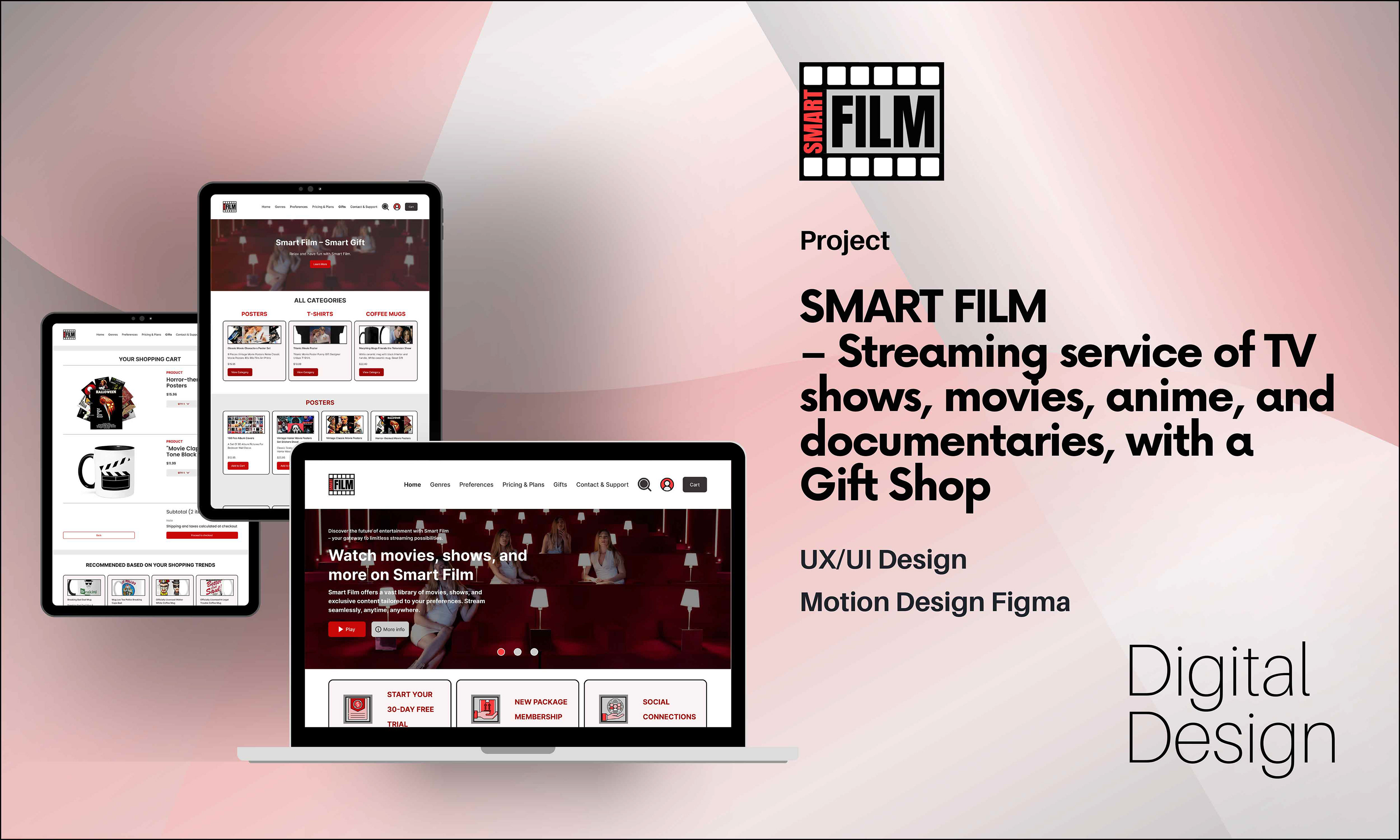
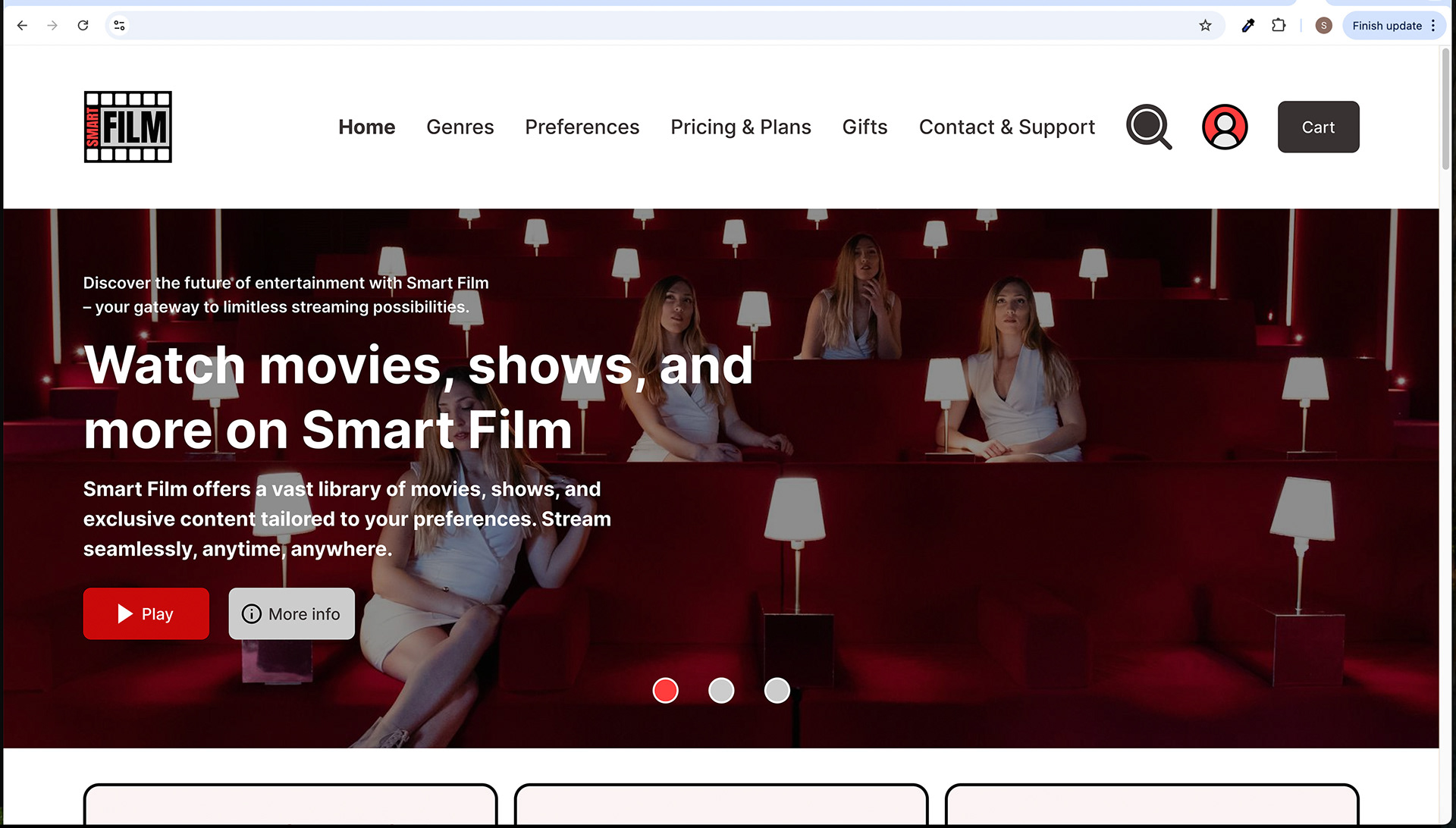

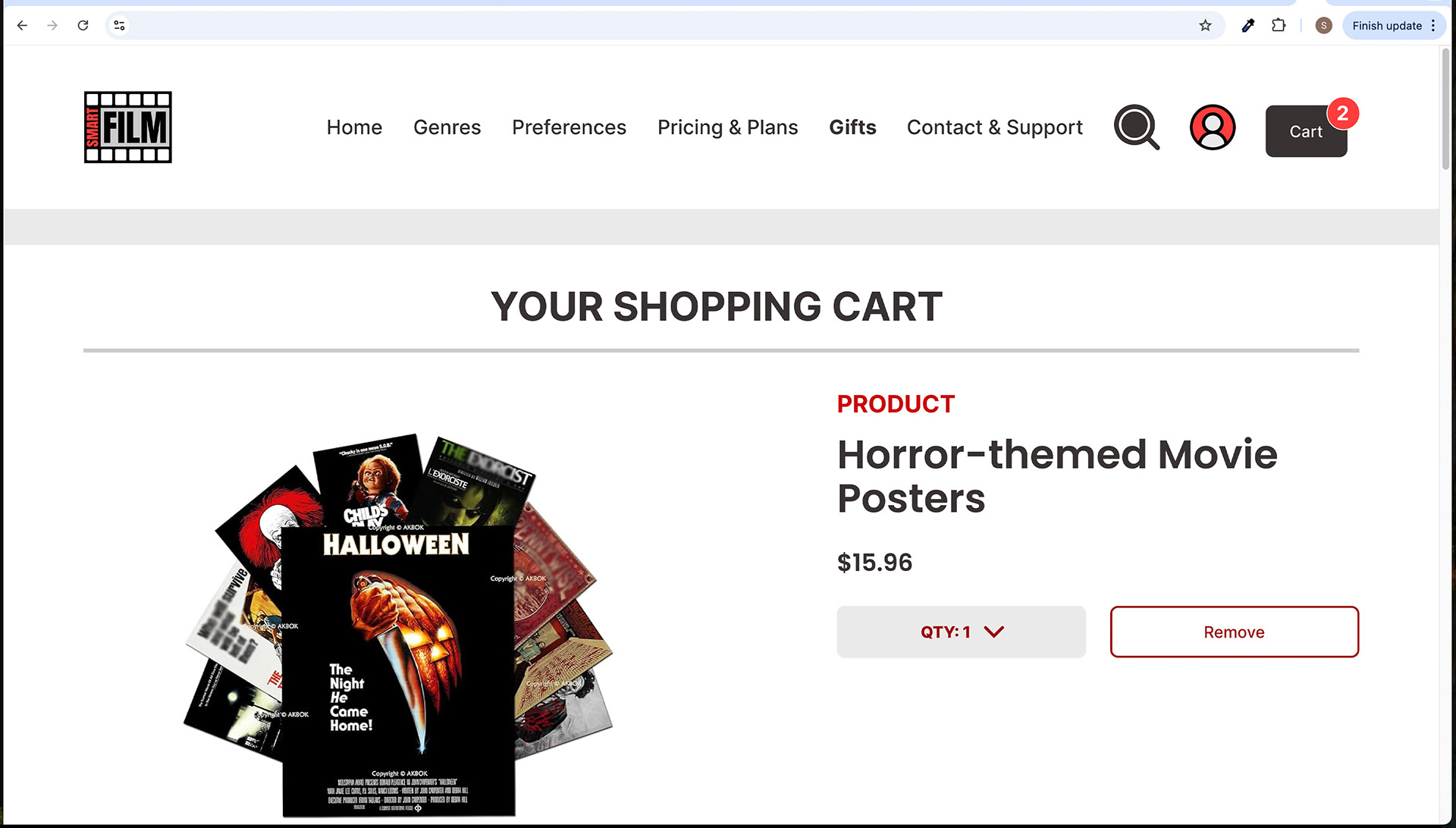



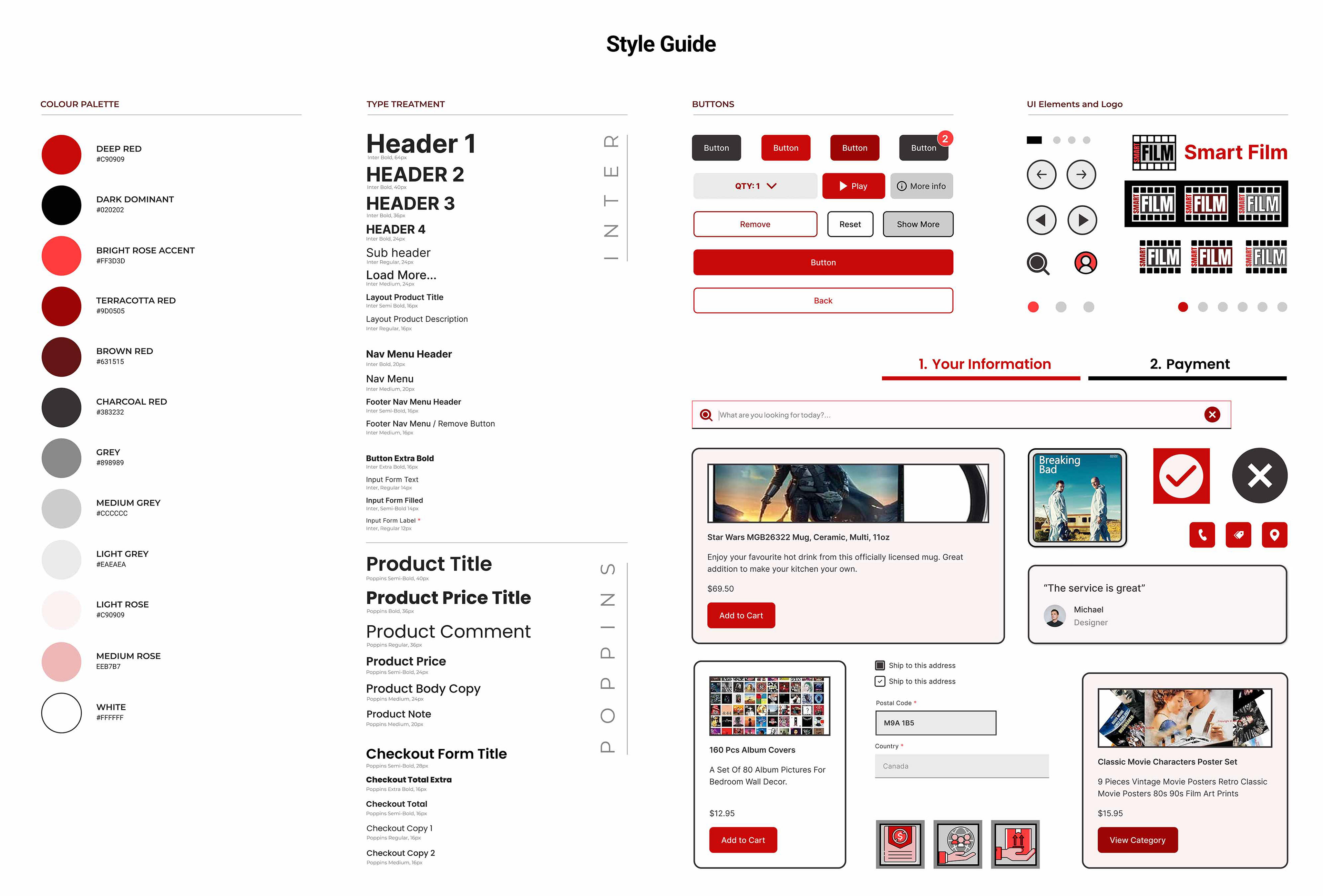

SMART FILM – Streaming service of TV shows, movies, anime, and documentaries, with a Gift Shop
Clickable Prototype
Copy the Link & View the Clickable Figma Prototype: SMART FILM – Streaming service of TV shows, movies, anime, and documentaries, with a Gift Shop (Home):
https://www.figma.com/proto/irmeVPqAb3V8OFS3MJmRmN/Smart-Film-Website_E-Commerce?node-id=8463-49837&node-type=frame&t=728JlF6T1rke29ck-0&scaling=min-zoom&content-scaling=fixed&page-id=4027%3A7737&starting-point-node-id=8463%3A49837&hide-ui=1
Copy the Link & View the Clickable Figma Prototype: SMART FILM – Streaming service of TV shows, movies, anime, and documentaries, with a Gift Shop (Gift Shop & Checkout):
https://www.figma.com/proto/irmeVPqAb3V8OFS3MJmRmN/Smart-Film-Website_E-Commerce?node-id=8463-49615&node-type=frame&t=728JlF6T1rke29ck-0&scaling=min-zoom&content-scaling=fixed&page-id=4027%3A7737&starting-point-node-id=8463%3A49615&hide-ui=1
UX DESIGN
SMART FILM – Streaming service of TV shows, movies, anime, and documentaries, with a Gift Shop

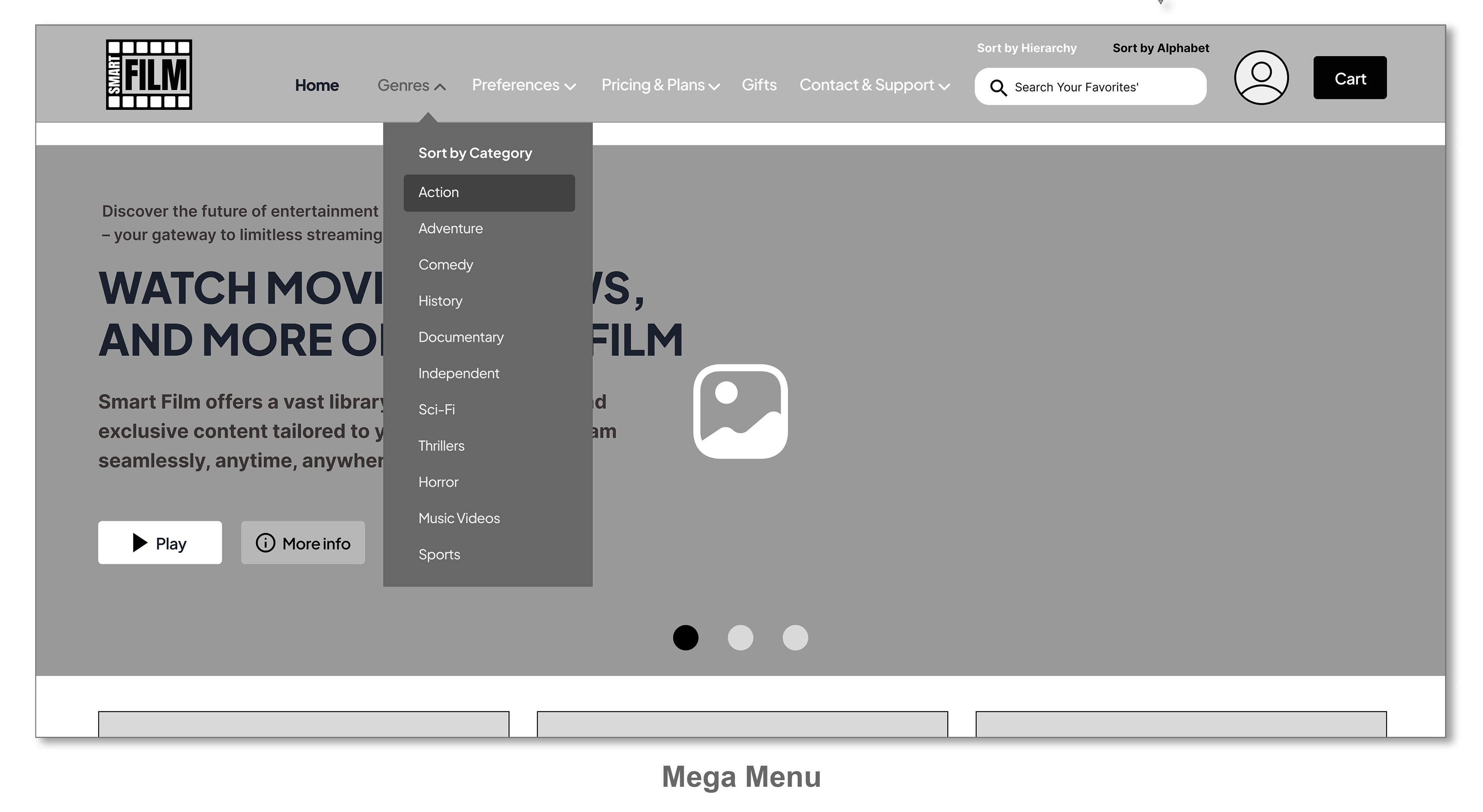
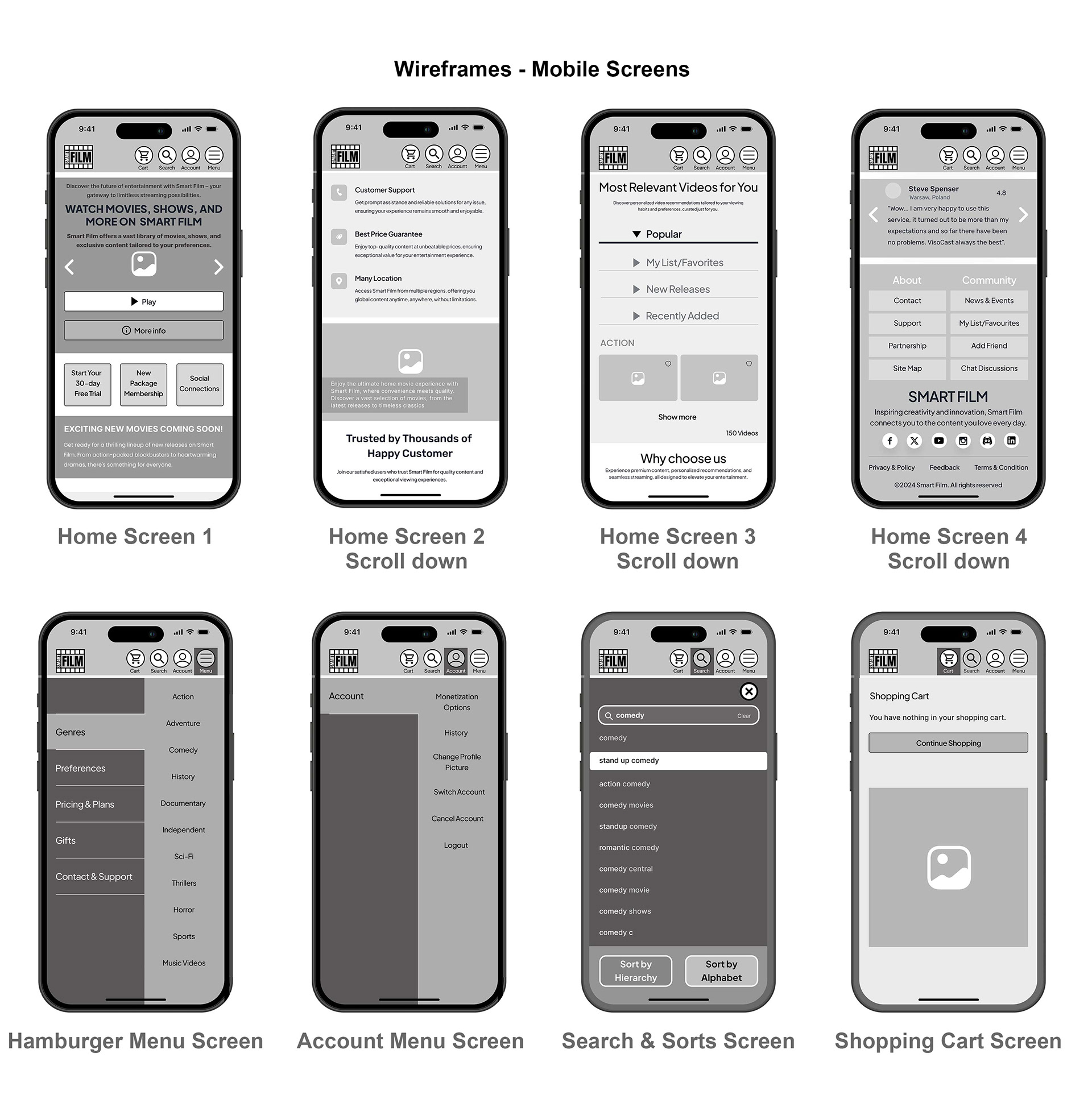
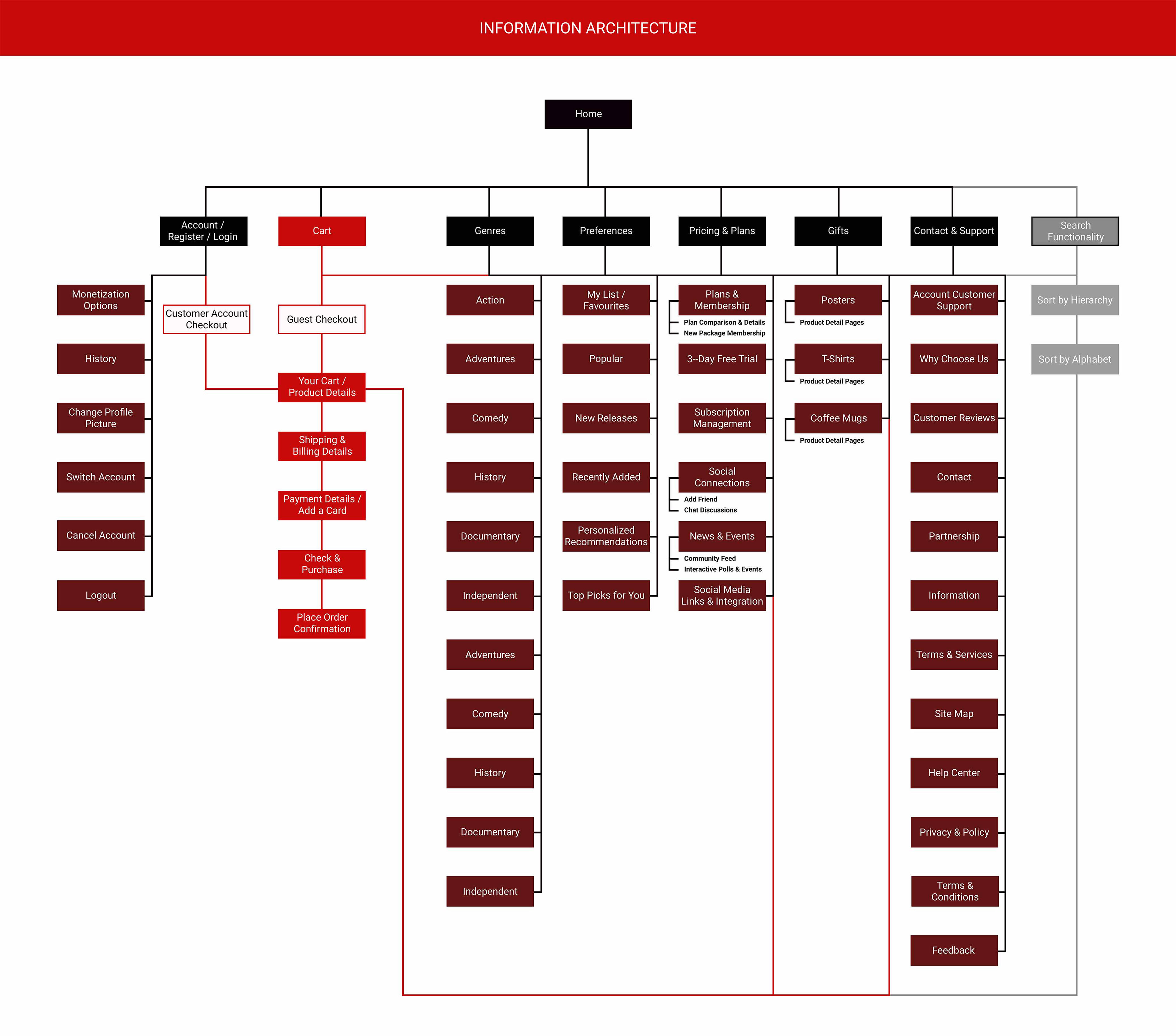
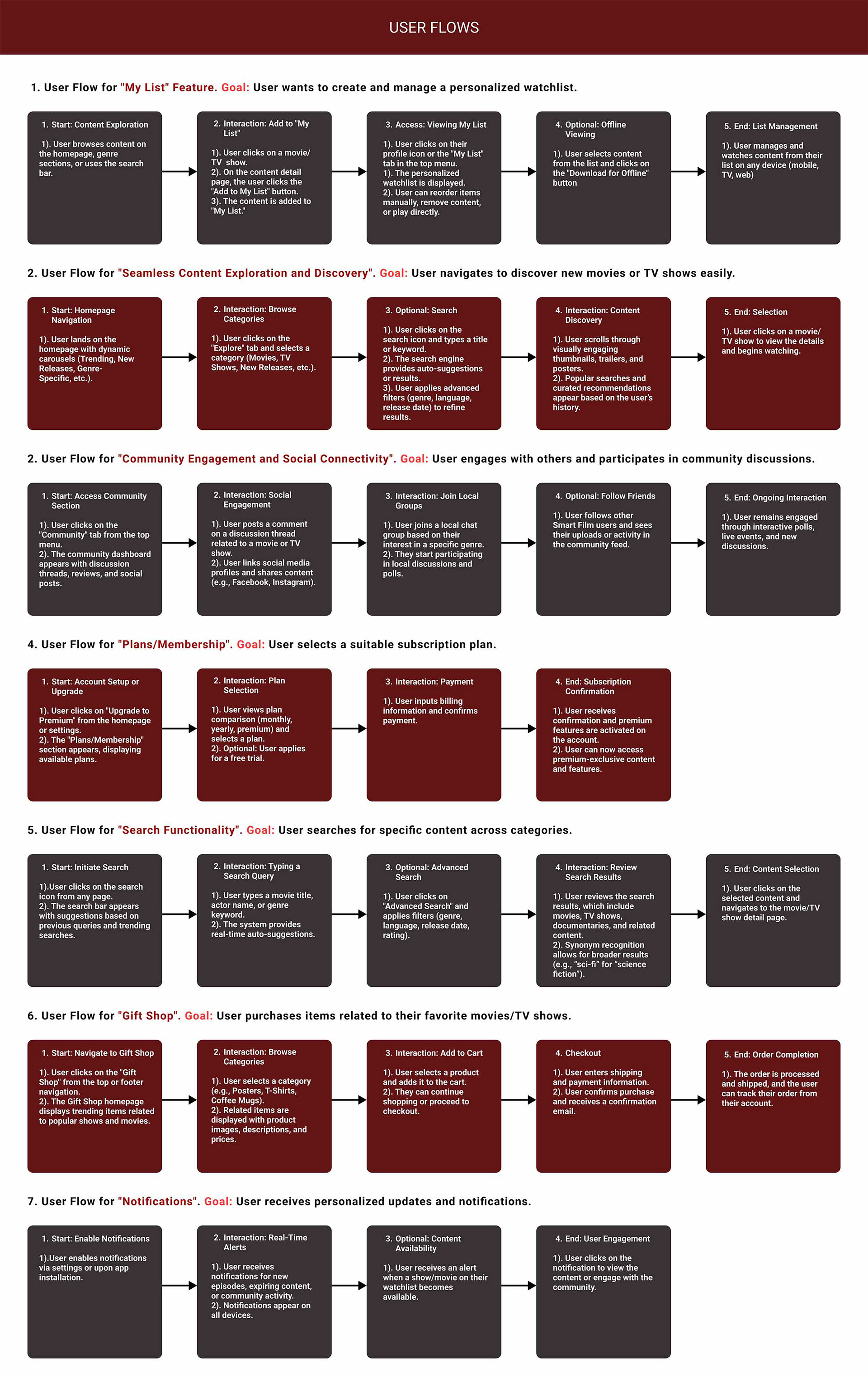
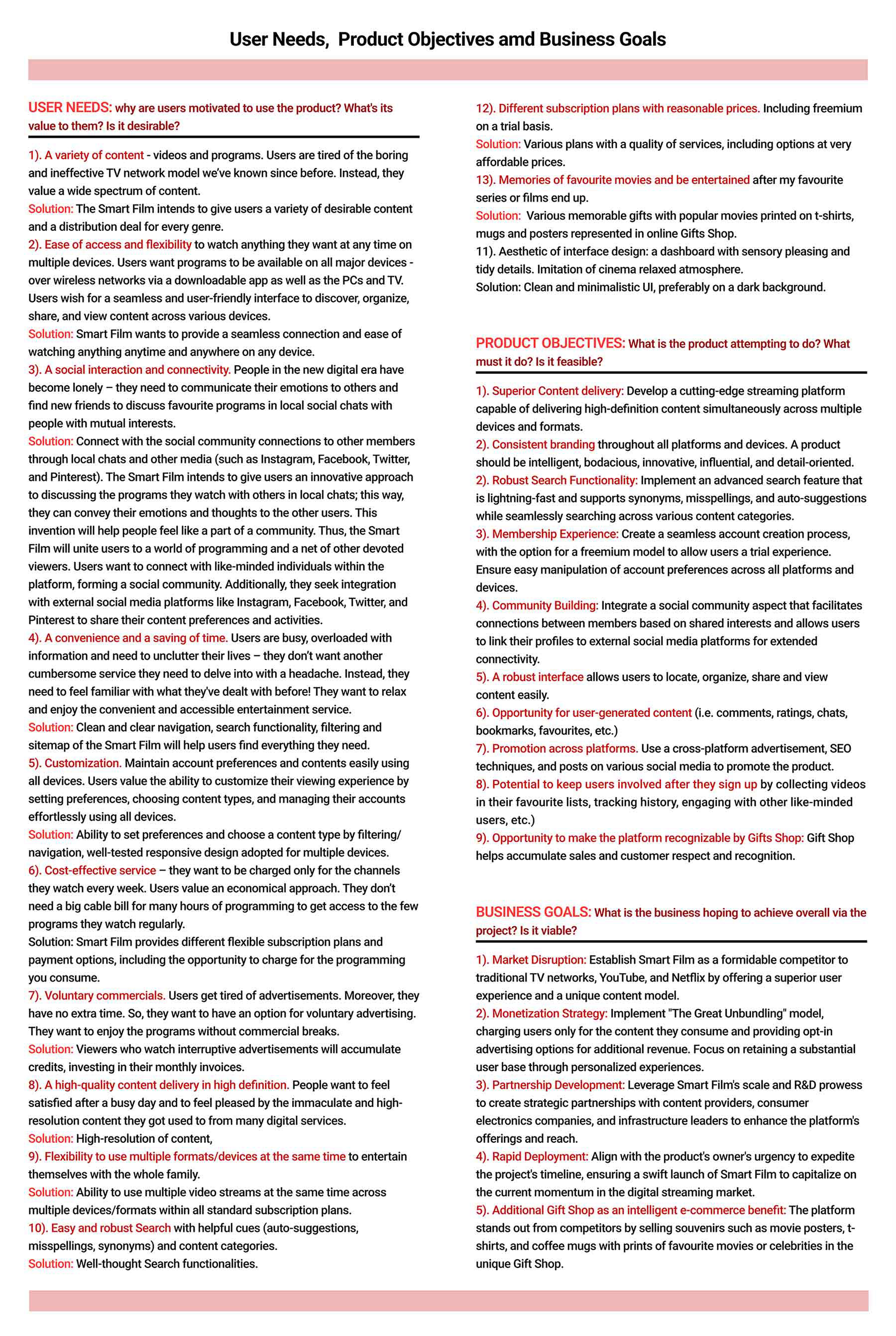
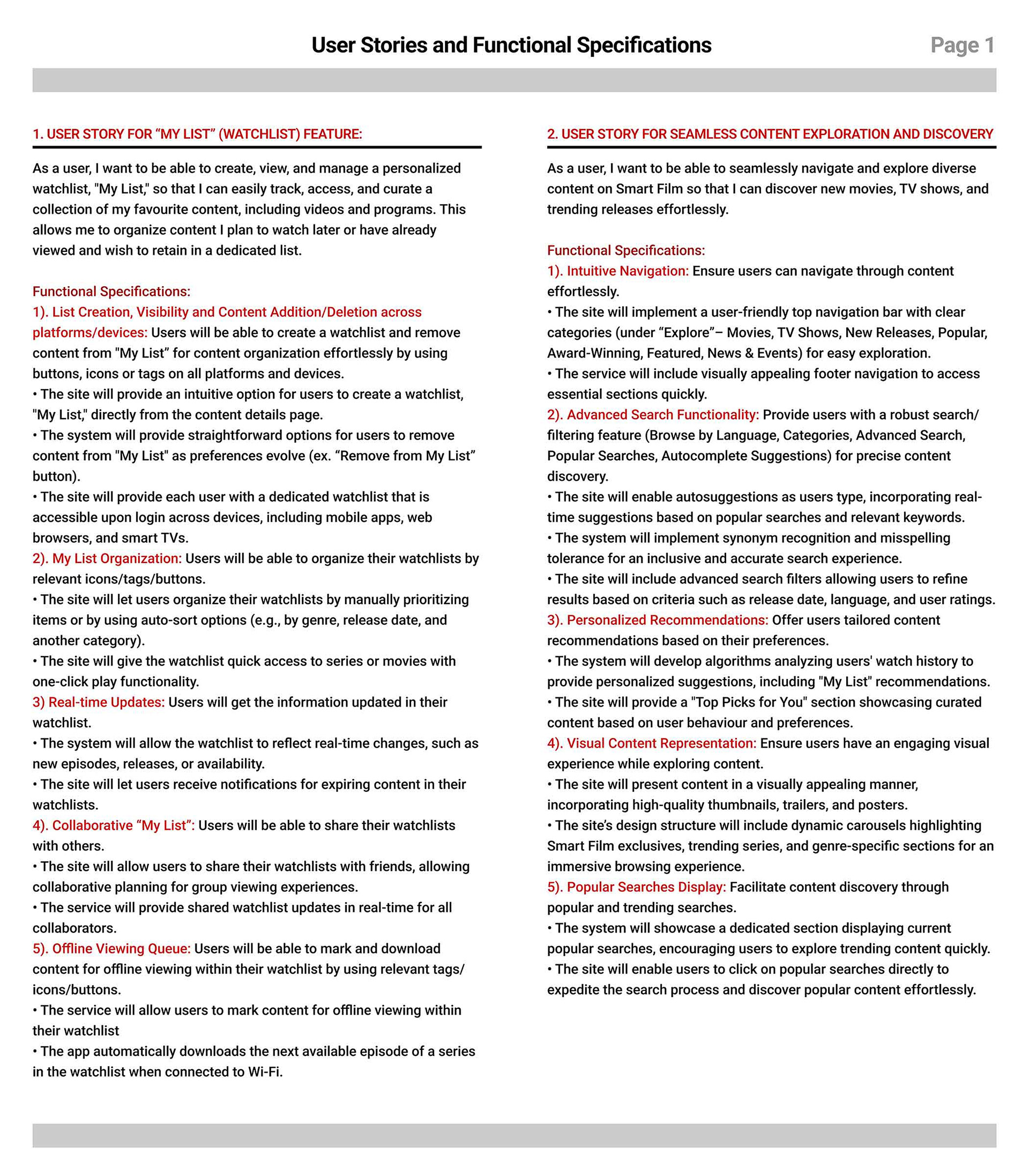

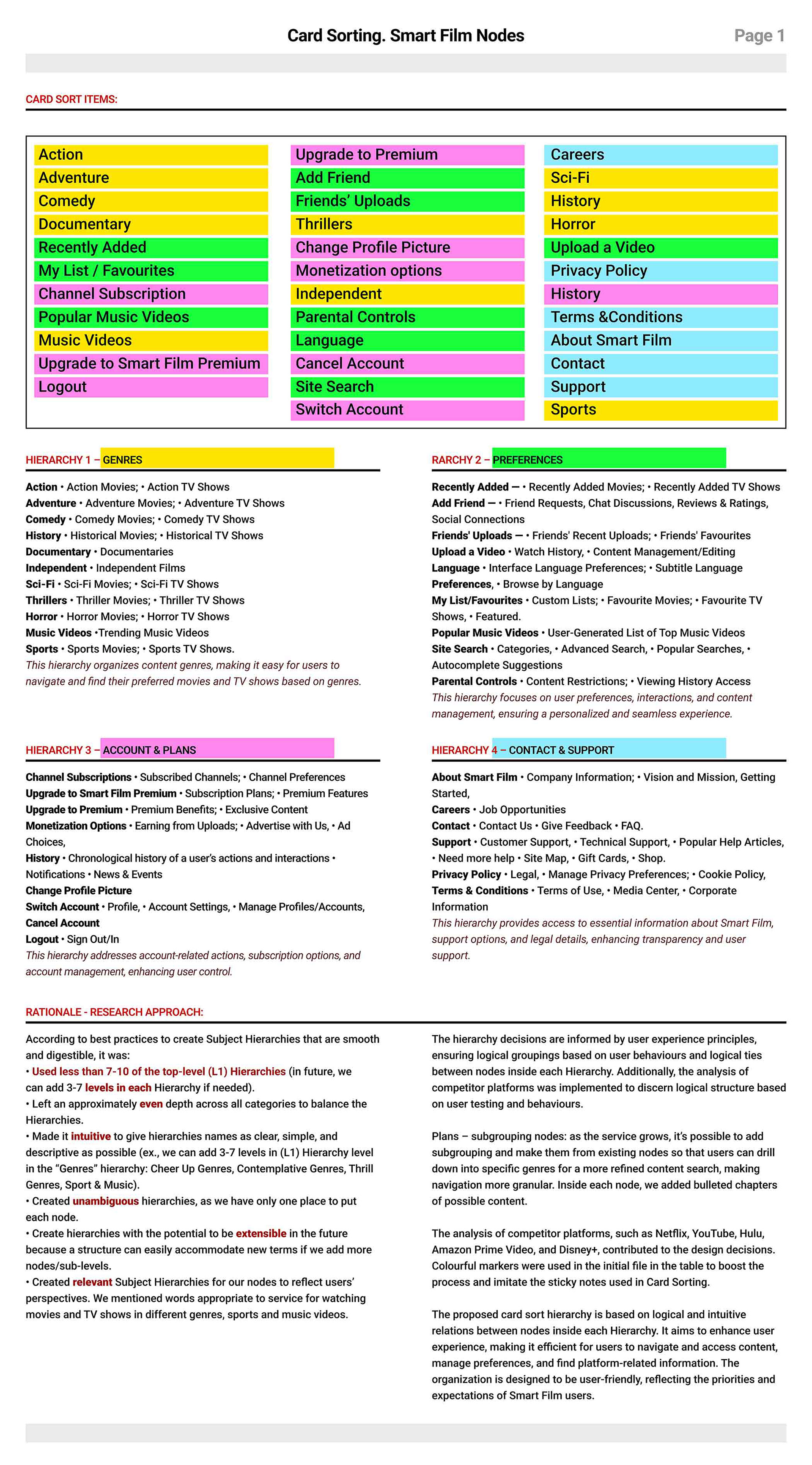
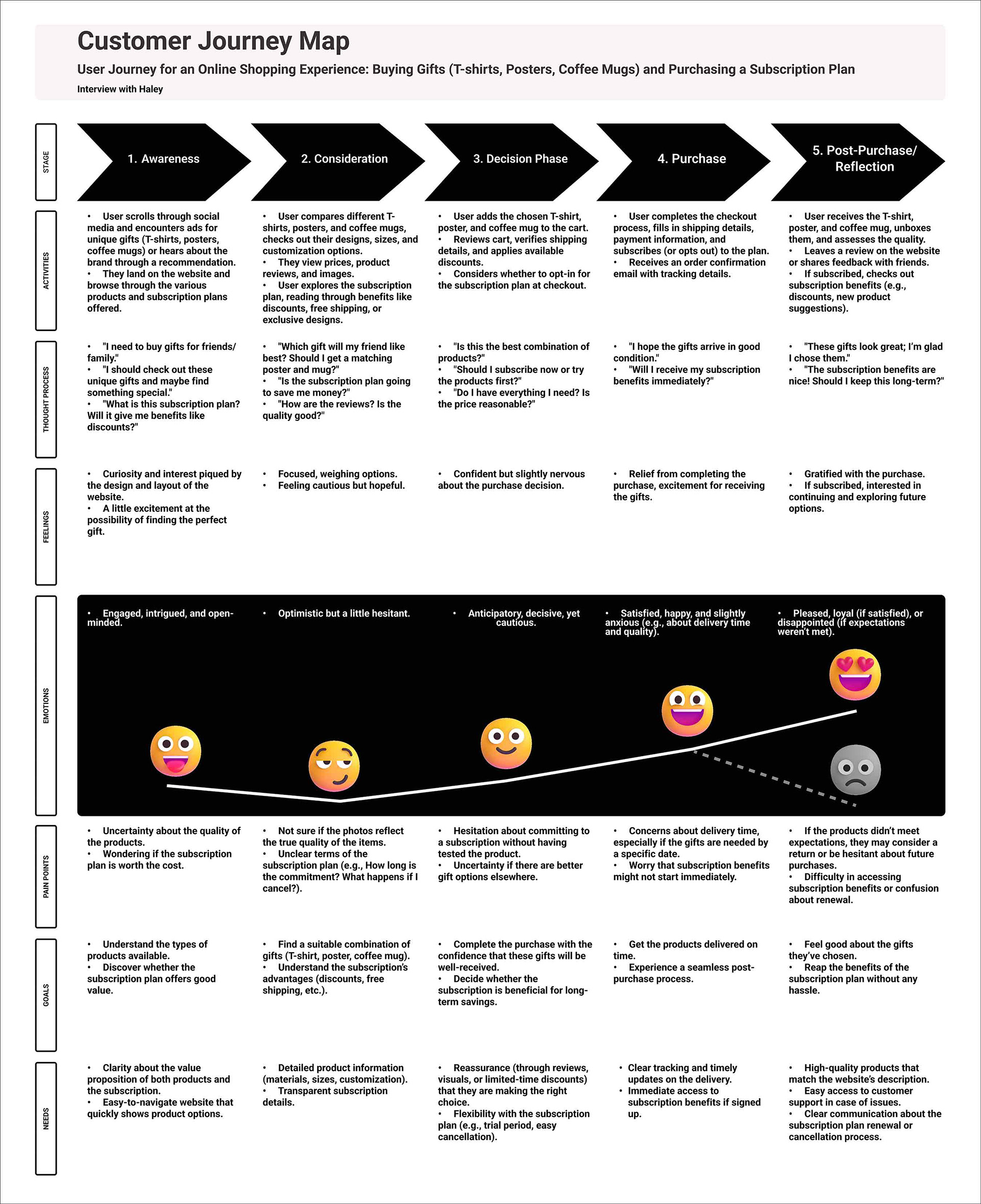
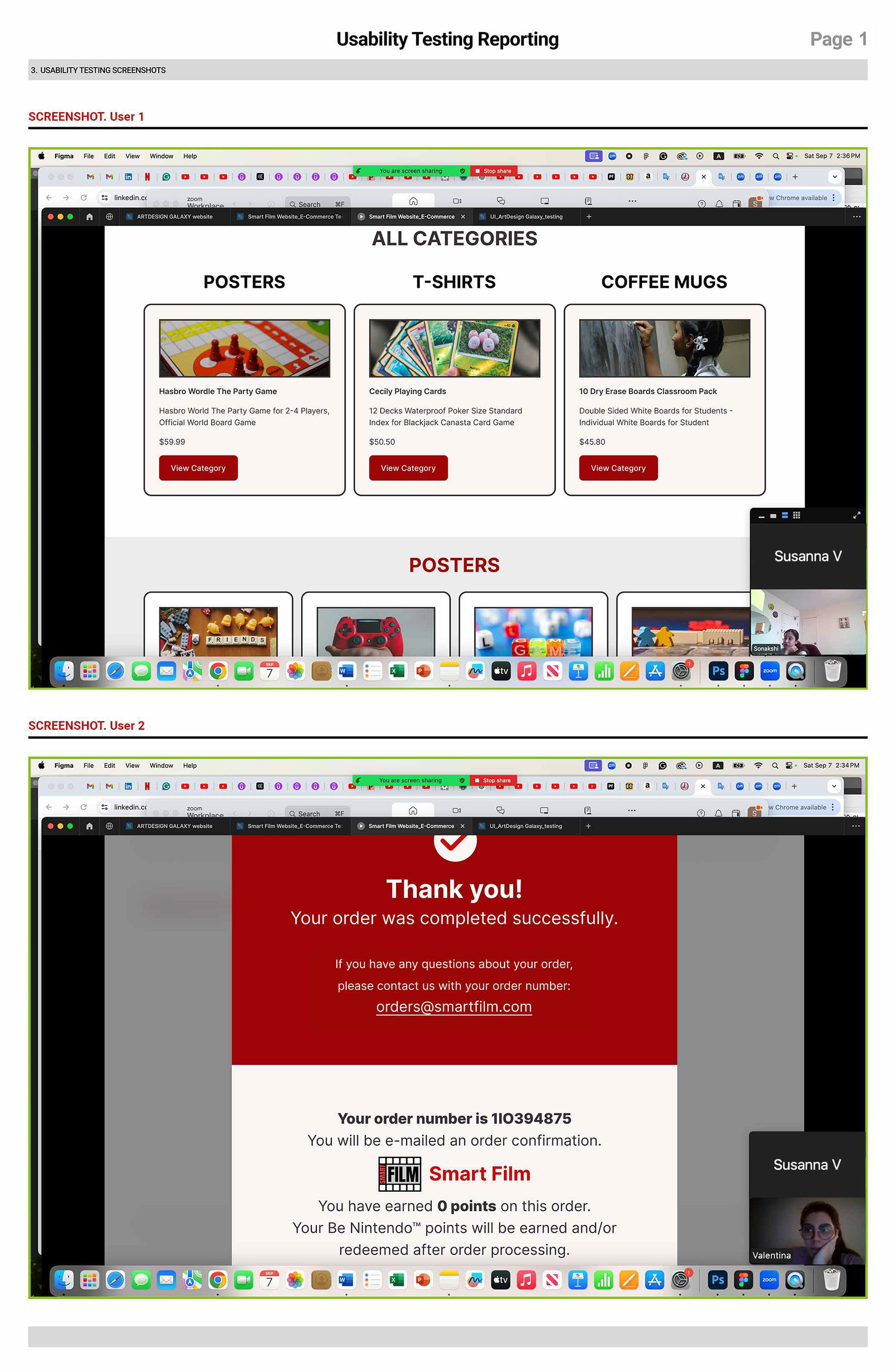
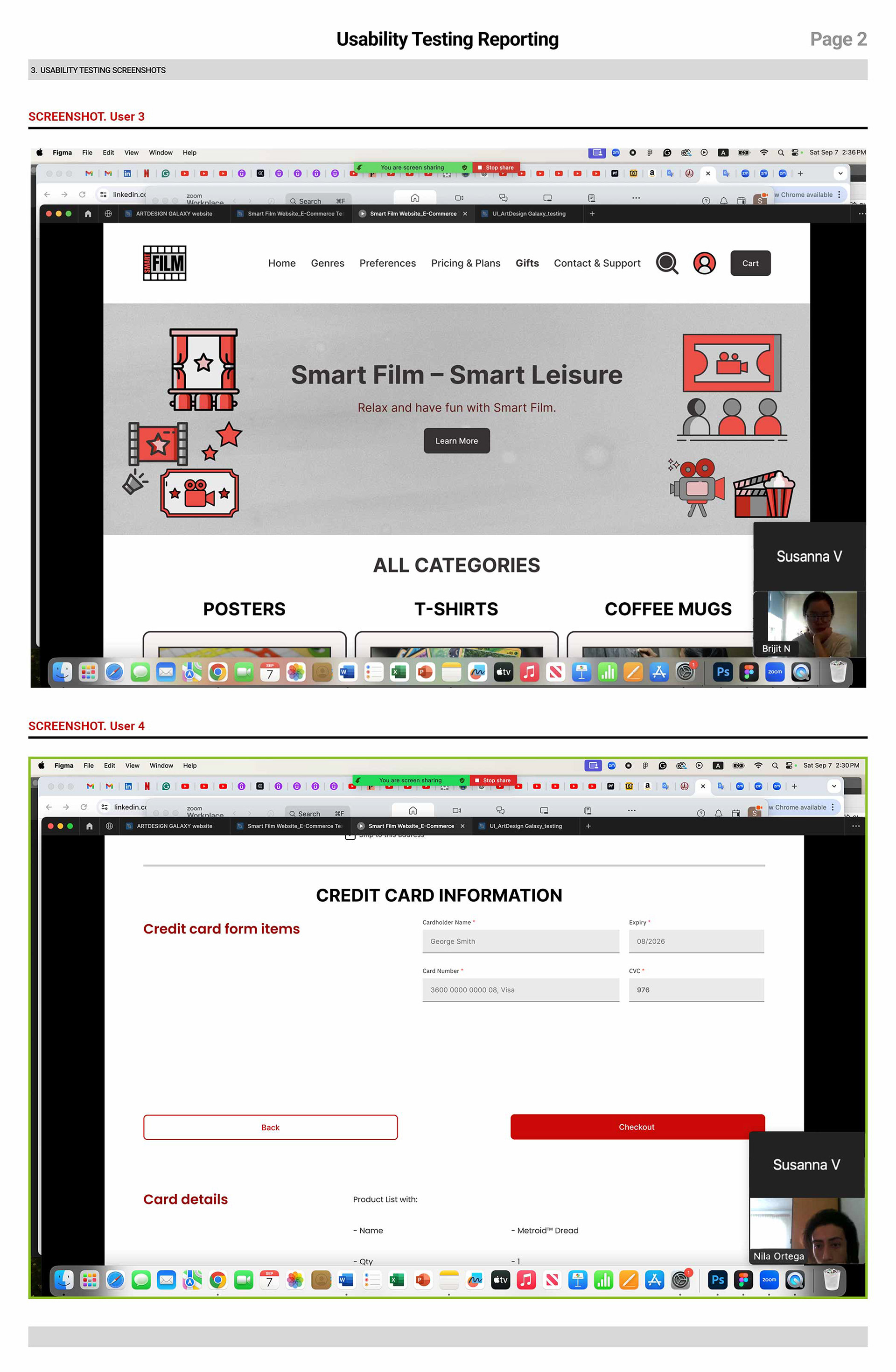
Role and Project Information
Branding, UX/ UI Design (Home, Gift, Checkout, Modal pages). Desktop (UX/UI) and Mobile (UX) design. Design, prototyping, and animation using Figma.
Role: UX/UI Designer. Tools: Figma, Photoshop, Illustrator, Canva. Timeline: 2.5 months (2024).
Collaboration: As a UX/UI designer, I collaborated with the designer, developer and product owner. I was responsible for branding and determining the overall design direction of the project while collaborating with the rest of the team on the creativity and implementation.
Introduction
Intro
This project outlines the user journey for purchasing gifts, including T-shirts, posters, and coffee mugs, and subscribing to a plan in an online shop. It enhances the overall experience by addressing user activities, thought processes, emotions, goals, and pain points at each phase. By analyzing these touchpoints, we aim to create a streamlined and user-centric shopping experience that meets customer needs efficiently, from product discovery to post-purchase support.
Problem Statement
The problem is that users often need help with online shopping due to complex navigation, unclear product information, and cumbersome checkout processes. Additionally, managing subscriptions alongside one-time purchases can be confusing. The goal is to simplify the user experience by improving clarity, ease of access, and seamless integration of gift purchases and subscription management.
Purpose
This project aims to design an intuitive, user-friendly online shopping experience that simplifies purchasing gifts (such as T-shirts, posters, and coffee mugs) and managing subscriptions. This will enhance customer satisfaction by offering a seamless, efficient, and engaging platform for one-time purchases and recurring services.
Primary product offerings
The primary product offerings for this project include:
•. Subscription Plans (flexible and tailored to user preferences)
•. T-Shirts
•. Posters
•. Coffee Mugs
These products aim to provide a unique gift experience with convenience and customization options.
Location
The online shop is accessible globally, providing a seamless shopping experience for users across various locations. The platform ensures convenient access to its products and subscription services, offering worldwide shipping options for physical items like T-shirts, posters, and coffee mugs.
Project Brief
Competitors
Competitors Overview
Competitors for the leading TV service include major streaming platforms such as YouTube and Netflix, which dominate the market by offering vast content libraries, user-friendly interfaces, and subscription models. The movie Gift Shop component provides an additional service, creating a unique selling point through branded merchandise and movie-related gifts that complement the leading service. This extension could also face competition from e-commerce platforms like Redbubble, Society6, Zazzle, and Etsy, known for personalized merchandise offerings.
In addition to YouTube and Netflix, competitors for the leading TV service include:
•. Amazon Prime Video: Offers a vast selection of movies, TV shows, and original content with added benefits for Amazon Prime members.
•. Hulu: Known for streaming TV shows shortly after they air live, along with an extensive library of films and series.
•. Disney+: Focuses on family-friendly content and blockbuster franchises like Marvel, Star Wars, and Pixar.
•. HBO Max: Combines HBO's premium content with a broader range of movies and series from WarnerMedia.
•. Apple TV+: Features original programming with an emphasis on high-quality storytelling.
•. Peacock: NBC's streaming service, offering a mix of free and premium content, including live TV and on-demand shows.
•. Paramount+: Provides many films, series, and live sports, targeting a broad audience.
These platforms offer diverse content libraries, user engagement, and competitive pricing, making them key players in the streaming market.
Target Market:
The target market for the TV service includes:
1. Streaming Enthusiasts: Individuals prioritizing on-demand, high-quality entertainment and multi-device access.
2. Families: Households seeking family-friendly content, including movies, TV shows, and kid-specific programming.
3. Tech-Savvy Millennials and Gen Z: Younger audiences looking for flexibility, social interaction features, and personalized content recommendations.
4. Binge Watchers: Users prefer bulk consumption of series or movies with features like favourites, history tracking, and community interaction.
5. Budget-Conscious Viewers: Those looking for cost-effective subscription plans with flexible pricing models and trial options.
6. Content Creators and Curators: Users enjoy engaging with or rating content, leaving reviews, and participating in online discussions.
7. Multi-Device Users: People who consume content across smartphones, tablets, smart TVs, and laptops, seeking seamless experiences across platforms.
This audience values convenience, customization, and affordability in their streaming services.
The platform offers a distinct, integrated experience, combining a TV service with an exclusive Gift Shop. The Gift Shop stands out by selling merchandise like t-shirts, posters, and coffee mugs featuring prints from popular movies available on the platform. This unique offering not only enhances user engagement but also creates a lasting connection between the viewers and their favourite films, setting the platform apart from competitors like YouTube, Netflix, and Hulu. This seamless integration ties entertainment and merchandise, making the service more memorable and valuable.
Competitors, Their Strengths, Opportunities, and Weaknesses
Competitors:
1. YouTube
•. Strengths: Vast content library, user-generated content, free access to ads.
•. Opportunities: Expand premium content and exclusive series.
•. Weaknesses: Inconsistent content quality, ad-heavy for free users.
•. Strengths: Vast content library, user-generated content, free access to ads.
•. Opportunities: Expand premium content and exclusive series.
•. Weaknesses: Inconsistent content quality, ad-heavy for free users.
2. Netflix
•. Strengths: Extensive original content, global reach, no ads.
•. Opportunities: Further content diversification and international market expansion.
•. Weaknesses: Increasing subscription prices and competition from new platforms.
•. Strengths: Extensive original content, global reach, no ads.
•. Opportunities: Further content diversification and international market expansion.
•. Weaknesses: Increasing subscription prices and competition from new platforms.
3. Hulu
•. Strengths: Combo of live TV and on-demand streaming, diverse content.
•. Opportunities: Grow live TV options and enhance regional content.
•. Weaknesses: Ads on lower tiers, limited global presence.
•. Strengths: Combo of live TV and on-demand streaming, diverse content.
•. Opportunities: Grow live TV options and enhance regional content.
•. Weaknesses: Ads on lower tiers, limited global presence.
Market Analysis:
The online streaming market is highly competitive, with companies focusing on original content, exclusive deals, and diverse libraries. The unique integration of a Gift Shop with favourite movie merchandise offers differentiation, creating an emotional connection that increases loyalty, which platforms like YouTube and Netflix lack. This multi-service approach taps into entertainment and e-commerce, expanding potential revenue streams and audience engagement.
Competitive Landscape Analysis:
Existing Solutions:
Competitors like YouTube, Netflix, and Hulu dominate the streaming space with extensive libraries, original content, and subscription models. YouTube offers user-generated content and free access, while Netflix excels in ad-free viewing and global reach. Hulu blends live TV with on-demand streaming.
Competitors like YouTube, Netflix, and Hulu dominate the streaming space with extensive libraries, original content, and subscription models. YouTube offers user-generated content and free access, while Netflix excels in ad-free viewing and global reach. Hulu blends live TV with on-demand streaming.
Opportunities for Differentiation:
The integration of a Gift Shop selling movie-themed merchandise sets the platform apart, offering a memorable experience that competitors lack. This fusion of streaming and e-commerce builds stronger emotional ties with users, enhancing brand loyalty and providing an additional revenue stream.
The integration of a Gift Shop selling movie-themed merchandise sets the platform apart, offering a memorable experience that competitors lack. This fusion of streaming and e-commerce builds stronger emotional ties with users, enhancing brand loyalty and providing an additional revenue stream.
Project Description:
This project focuses on developing a unique streaming platform that offers a mix of high-quality content, flexible subscription plans, and a memorable user experience. The platform integrates a Gift Shop that sells merchandise featuring popular movies, creating a standout feature that combines entertainment with e-commerce. This service differentiates itself from competitors like Netflix and YouTube by providing users exclusive merchandise tied to their favourite films, fostering a deeper connection with the platform.
Services
The platform offers two primary services:
1. Streaming Service: High-quality content delivery with flexible subscription plans, personalized viewing options, and seamless multi-device access. Features include community interaction, voluntary ads with credit incentives, and user-generated content like ratings and bookmarks.
2. Gift Shop: A unique e-commerce extension selling merchandise with prints from users' favourite movies, providing an additional layer of engagement and revenue. This shop distinguishes the platform, connecting users to their favourite films through tangible, memorable products.
Objective
1. Enhance User Experience: Deliver high-quality, customizable content across multiple devices with an intuitive interface.
2. Foster Community: Build a connected community through social interaction, chats, and user-generated content.
3. Increase Engagement: Drive engagement with voluntary ads offering credits and a personalized experience based on viewing history.0
4. Monetize with Flexibility: Offer a freemium model with tiered subscription plans and flexible payment options.
5. Differentiate through Merchandise: Strengthen the platform’s identity by offering a unique gift shop featuring merchandise with prints from favourite movies, enhancing user loyalty and providing an additional revenue stream.
How the Project Stands Out
The project stands out by combining a premium streaming service with a unique Gift Shop that sells merchandise featuring prints from users’ favourite movies. This fusion of content consumption and physical memorabilia offers a memorable, personalized experience that differentiates the platform from competitors like YouTube and Netflix. Additionally, the platform focuses on community engagement, voluntary ad participation with credit incentives, and a customizable user experience with flexible subscription options, enhancing user satisfaction and loyalty.
Project Goals
The project's goals are:
1. Disrupt the streaming market by providing a unique blend of content delivery and physical merchandise through the Gift Shop.
2. Enhance user engagement with customizable viewing experiences and community-building features.
3. Monetize effectively with flexible subscription plans and voluntary ads for credit incentives.
4. Provide superior content delivery across multiple devices with a seamless user interface.
5. Leverage brand loyalty through exclusive merchandise tied to users' favourite movies.
6. Build strategic partnerships with content creators and infrastructure providers to expand the platform's offerings.
Business Goals
The business goals are:
1. Increase market share by offering a distinctive combination of streaming services and movie-themed merchandise through the Gift Shop.
2. Maximize revenue streams with flexible subscription plans, voluntary ad integration, and the sale of exclusive, branded merchandise.
3. Expand customer base by targeting a broad audience, including movie enthusiasts and collectors of film memorabilia.
4. Foster partnerships - with studios, content providers, and merchandise producers to strengthen content offerings and diversify products.
5. Build brand recognition by creating a memorable platform that ties streaming entertainment with collectible items, enhancing user loyalty.
6. Drive engagement through community features, social media integration, and personalized content recommendations.
Project Vision
The project vision is to create a seamless entertainment platform that combines high-quality streaming content with a unique Gift Shop offering movie-themed merchandise. By blending entertainment and commerce, the platform aims to enhance user engagement, foster community interaction, and deliver a memorable, personalized viewing experience. The goal is to stand out in the competitive market by offering flexible subscription plans and exclusive collectibles, positioning the platform as a one-stop hub for film lovers.
Target Audience
The target audience includes movie enthusiasts, casual viewers, and collectors seeking personalized entertainment experiences. This group values high-quality streaming, flexible subscription options, exclusive merchandise tied to favourite films, and community interaction. The platform appeals to a tech-savvy, socially engaged audience across various age groups looking for convenience, personalization, and unique memorabilia.
The Strategy of the UX Project Process
The UX project strategy includes the following key steps:
1. Research & Stakeholder Interviews: Gathering insights through user and stakeholder interviews to understand needs, goals, and pain points.
2. Customer Journey Mapping: Visualizing user interactions and identifying areas for improvement.
3. User Stories & User Flows: Outlining desired actions and paths for a seamless experience.
4. Design & Prototyping: Creating wireframes and interactive prototypes that reflect intuitive and visually appealing interfaces.
5. Card Sorting: Enhancing navigation by organizing information architecture through user-driven card sorting.
6. User Testing: Conduct tests with real users to identify pain points and usability issues, iterating based on feedback.
7. Usability Testing: Refining designs and optimizing user experience through targeted usability tests.
8. Research & Analysis: Ongoing market and user research to adapt the platform to changing needs and trends.
9. Community Integration: Building engagement through community features such as forums, chats, and social media integration.
10. Iterative Development: Continuously improving based on research, testing, and feedback.
This strategy ensures a user-friendly, community-centered platform with continuous improvement and alignment with user and business goals.
Principles of the website design for the project:
1. User-Centric: Prioritizing easy access to TV content and Gift Shop with simple, intuitive navigation across all devices.
2. Visual Appeal: Engaging, sensory-rich design highlighting movie content and exclusive merchandise.
3. Seamless Integration: Effortless transitions between streaming services and the Gift Shop, keeping the experience unified and cohesive.
4. Personalization: Customized recommendations for TV shows, movies, and merchandise based on user preferences and history.
5. Community Integration: Features like user reviews, chats, and social media sharing to foster community engagement around content and products.
6. Consistency: Harmonized visual branding across the streaming service and Gift Shop, reinforcing the connection between both.
7. Efficiency: Quick, easy-to-use purchasing flows for subscriptions and merchandise, minimizing effort and time spent.
8. Scalability: Designed to accommodate future expansion in content offerings, merchandise, and user features.
These principles reflect the project's commitment to delivering a dynamic, engaging, and streamlined user experience.
Type the Product
The product is a dual-service platform offering a TV streaming service with exclusive content and a Gift Shop selling merchandise featuring prints from users' favourite movies. Integrating both services makes the platform unique, allowing users to enjoy high-quality streaming while purchasing memorable merchandise tied to the shows and films they love.
Strengths and Opportunities:
Strengths:
•. Unique Dual-Service: Combines TV streaming with a dedicated Gift Shop, offering exclusive movie-themed merchandise.
•. Personalization: Tailored content recommendations and customizable merchandise make the experience highly personalized.
•. High-Quality Content: Offers high-definition streaming with flexible subscription plans, attracting diverse user segments.
•. Community Engagement: Integrated social features, such as community chats and user-generated content, foster engagement.
Opportunities:
•. Niche Market: Capitalize on the growing demand for personalized entertainment experiences and exclusive merchandise.
•. Partnerships: Collaborations with film studios and brands to expand the range of collectible merchandise.
•. Emerging Technologies: Incorporate AR/VR for enhanced product interaction and immersive viewing experiences.
•. Global Reach: Expand into international markets with region-specific content and merchandise.
Conducted User Research:
Through interviews, surveys, and usability testing, we gathered insights into user preferences for both streaming content and shopping experiences. Users value easy-to-use, seamless integration between TV content and merchandise and personalized recommendations. Pain points included complex interfaces and a lack of social interaction features, driving design improvements for a more intuitive, community-centric platform.
Market Trends and Customer Expectations:
Current market trends show a shift toward personalized content delivery, flexible subscription models, and integrated shopping experiences. Customers expect seamless multi-device access, high-quality streaming, and the ability to purchase related merchandise easily. The rise of community-driven engagement and social features also drives customer demand for interactive, customizable experiences across entertainment and shopping platforms.
Project Overview:
The project aims to create a unique streaming platform that offers high-quality content alongside an integrated gift shop selling merchandise with prints of favourite movies. It stands out by combining seamless content delivery with an e-commerce experience, fostering community interaction, and providing personalized subscription plans. The platform will challenge competitors like Netflix and YouTube by offering exclusive user engagement features, flexible pricing, and a memorable shopping experience tied to popular movie content.
User Discovery & Research
User Testing
We conducted user testing by selecting a group of target users and guiding them through critical tasks such as browsing genres, purchasing subscriptions, and shopping for gifts. Participants provided feedback on navigation, ease of use, and overall satisfaction. We observed their interactions, noting pain points and areas of confusion, which informed iterative improvements to the platform's design and functionality for desktop and mobile versions.
Stakeholder Interview
Stakeholder Interview: Questions and Answers with a Netflix Stakeholder (Toronto, Canada)
1. Can you provide insights into the diverse range of users who utilize Netflix for their entertainment needs, considering age, employment status, ethnicity, gender, family size, literacy, and marital status?
Answer: – Netflix has a broad demographic spread, but the most significant portion of our users are in their 20s to 40s, both male and female. A substantial percentage are young adults, often single or living with roommates. There is also a considerable audience of married couples with children. Professionally, we see a lot of white-collar professionals, students, and educators. Our user base is highly diverse, spanning various ethnicities and family sizes.
2. What are some key characteristics or traits you've observed among Netflix users?
Answer: – Netflix users are typically tech-savvy, enjoy binge-watching series, and prefer streaming content across multiple devices like smart TVs, laptops, and smartphones. They value convenience, personalized recommendations, and a wide range of genre options. Many of our users watch content during commutes, downtime, or as part of their family routines.
3. How do you perceive the different needs and priorities of various user groups when it comes to using Netflix?
Answer: – Younger users prioritize convenience and mobility, often using their smartphones to stream on the go, while families are interested in children’s programming and parental controls. Binge-watchers love the seamless transition between episodes, while casual viewers prioritize an easy-to-navigate user interface. Some users are more inclined toward international content, while others prefer local or original productions.
4. How do you describe the various user groups when it comes to using Netflix, considering their urban/rural/peri-urban residence, region, district, hamlet, neighbourhood, and lifestyle activities?
Answer: – Netflix is popular across both urban and rural areas. Urban users, especially those in metropolitan regions like Toronto, often have higher-speed internet and more tech-forward lifestyles, making them heavy streaming service consumers. Meanwhile, rural users tend to be more family-oriented and may prioritize family-friendly content. We’ve noticed urban professionals prefer thrillers and documentaries, while suburban and rural users gravitate towards family programming and drama series.
5. In your experience, what demographic groups tend to be the most frequent users of Netflix?
Answer: – Millennials and Gen Z are our heaviest users, both male and female. Families with children also consume a large volume of content, particularly on weekends and holidays.
6. Can you tell me about any notable differences in usage patterns between different age groups of Netflix users?
Answer: – Younger users (20s and 30s) tend to explore a variety of genres and regularly binge-watch shows over short periods. They are more likely to engage with international content and Netflix Originals. Older users (40s and beyond) are more focused on specific genres like documentaries, dramas, and family content. They also spread out their viewing over longer periods.
7. What demographics or industries stand out regarding their usage patterns or preferences?
Answer: – The tech industry prefers sci-fi, tech-oriented thrillers, and dystopian narratives. Students lean toward anime and international content, while families gravitate toward animations, children’s content, and adventure series. We also see that professionals in the creative industries prefer original content and indie films.
8. Are there specific industries or professions that stand out as heavy users of Netflix? If so, what are their main reasons for using the platform?
Answer: – The creative industries—filmmakers, designers, marketers—are heavy Netflix users, primarily due to their interest in innovative and visually captivating content. We also find students, especially those in media or communication studies, using the platform as a reference for their academic projects.
9. From your perspective, what are the primary motivations behind why people choose Netflix over similar streaming platforms, considering their risk profile, social connectedness, social standing, and attitudes towards technology?
Answer: – Netflix offers a blend of original content, global reach, and affordability. Users appreciate the broad range of genres, as well as the ability to watch content on-demand. We also have a competitive edge due to our recommendation algorithm, which makes it easy for users to discover new shows tailored to their preferences. Netflix also excels at delivering content without interruptions from ads, which many users find crucial.
10. Are there any emerging trends or behaviours among Netflix users that you find particularly interesting or noteworthy, such as the duration and frequency of their Netflix usage, habits, the salience of behaviours, stage of change, and attitudes towards new features?
Answer: – Binge-watching is still a dominant behaviour, but we’re noticing more users breaking down their viewing into smaller sessions, perhaps due to busier schedules or shifting attention spans. Also, there's an increasing interest in international and multilingual content, suggesting viewers are becoming more open to global stories. Another emerging trend is the rise of shared viewing experiences through social media—users are discussing shows in real-time, creating a community-driven culture.
11. How does Netflix approach the process of gathering feedback and insights from its diverse user base to inform product development and feature enhancements?
Answer: – We rely heavily on user data and insights gathered from in-app feedback, surveys, and focus groups. Netflix also employs machine learning to analyze viewing habits and make adjustments to both content recommendations and user experience. We often beta-test new features with select user groups before a broader rollout.
12. Can you discuss any strategic initiatives or plans that Netflix has in place better to serve the needs of specific user segments or industries, considering users' use of technology, tech-savviness, geographic usage, and contextual opportunities?
Answer: – We are focusing on increasing our presence in underrepresented markets, such as smaller cities and rural areas, by offering more localized content. There’s also a push towards optimizing our platform for mobile use, especially in regions where internet access can be unstable. On the technology side, we’re integrating more AI to enhance the user experience, such as better subtitle accuracy and improved personalized recommendations.
13. In what ways does Netflix prioritize data privacy and security to address users' concerns and build trust, for example, taking into account their feedback provided over time or in context and their budget constraints and business goals?
Answer: – We adhere to strict data privacy regulations such as the GDPR and CCPA, and we ensure our users’ data is encrypted and secure. Users can control their privacy settings and access reports on how their data is being used. Netflix is also transparent about our privacy policies, which are easily accessible on our platform.
14. How do Netflix's customer service and content teams perceive and interact with different customer segments, considering their existing assumptions, beliefs, data & knowledge, and constraints, to ensure buy-in on content updates and new releases?
Answer: – We host regular engagement sessions with users, run surveys, and analyze social media trends. The content team is particularly keen on understanding which genres or shows resonate with different segments, and this helps inform future content investments. Our customer service team is trained to handle queries based on geographic and cultural contexts, ensuring that we can offer personalized support.
15. How does Netflix envision the future of streaming and entertainment, considering users' evolving needs, desires, and values from a solution and their reactions to technologies, along with their geographic usage and context-specific feedback?
Answer: – The future is leaning heavily towards immersive, interactive content. We’re investing in augmented reality (AR) and virtual reality (VR) features to offer unique viewing experiences. Additionally, we foresee more collaborative viewing options, where friends and family can share content virtually in real-time. Content-wise, we anticipate a shift towards more diverse, inclusive stories that cater to a global audience.
16. Can you share any anecdotes or stories that illustrate the varied ways in which people use Netflix in their personal or professional lives in terms of some common challenges or pain points that users encounter?
Answer: – One of our users, a university professor, mentioned how Netflix Originals has become part of his curriculum for teaching modern storytelling techniques. On the personal front, during the pandemic, we had families sharing that Netflix became a bonding experience as they watched series together in lockdown. One pain point we've encountered is the occasional internet throttling in rural areas, which can frustrate users when they try to stream in HD.
17. What do you believe are the main challenges or pain points that users face when utilizing Netflix?
Answer: – The primary pain point is related to bandwidth and internet speeds in certain regions, especially when streaming high-quality content like 4K or Ultra HD. Another challenge is navigating the sheer amount of content available—some users find it overwhelming. Finally, we’ve received feedback about subscription pricing as users compare Netflix with other emerging platforms.
18. Are there any emerging trends or behaviours among Netflix users that you find particularly interesting or noteworthy? How do you anticipate these trends shaping the future of streaming?
Answer: – We are seeing an uptick in co-viewing apps, where users can watch Netflix together from different locations. This trend of communal watching, driven by social media interactions, may lead to more interactive features in our platform. The appetite for diverse, global content is growing, so we expect to invest even more in international productions in the near future.
19. In what ways does Netflix prioritize accessibility and inclusivity in its product design and development process? How does Netflix ensure that its platform is accessible to users with diverse needs and abilities?
Answer: – We are committed to ensuring that Netflix is accessible to everyone. We provide options such as audio descriptions for visually impaired users and closed captions in multiple languages. Our interface is designed to be intuitive and user-friendly, catering to a wide range of abilities. We regularly collaborate with accessibility experts to improve our offerings and ensure compliance with international accessibility standards.
20. How does Netflix approach the process of segmenting its user base and tailoring its offerings to different audience segments? Can you provide examples of how Netflix customizes its features or services for specific user groups?
Answer: – Netflix uses sophisticated algorithms to segment users based on their viewing history, preferences, and location. For example, users in India may see a more Bollywood-centric content feed, while users in the U.S. might get more Hollywood recommendations. We also customize content based on language preferences, offering multilingual subtitles and dubs.
21. What are the primary reasons why users might upgrade to premium or higher-tier Netflix accounts?
Answer: – Upgrading allows for better viewing experiences, such as Ultra HD and access to multiple devices at once. Families, for instance, often upgrade to share the account across different household members. Additionally, premium accounts remove any viewing limits, which is attractive to users who want to stream simultaneously on different devices.
22. How do you think recent shifts towards remote work and virtual collaboration have impacted the usage of Netflix?
Answer: – Remote work has led to an increase in users streaming content during breaks or at the end of their workday. Many people have also used Netflix as background entertainment while working from home. This trend has boosted viewership during what used to be off-peak hours, indicating that work-life boundaries are becoming more fluid in this new normal.
Audience Segmentation
Audience Segments based on the Stakeholder Interview Answers
Audience 1: Entertainment Enthusiasts (Managers)
Demographics: Varied ages, primarily in their 30s and 40s, both genders, often married with children. Many reside in urban areas with a mix of residence types (condos and houses).
Psychographics: Socially connected, engaged in popular culture and entertainment and interested in leisure activities that help them unwind after a busy workday? They prefer easy access to high-quality content that can be shared with family or friends.
Professions: Communication Managers, Marketing Managers, General Managers.
Usage Patterns: They enjoy content that can be streamed on multiple devices—TV, mobile, and laptops. They often consume entertainment during evenings and weekends, favouring both popular films and TV series.
Priorities: High-quality streaming, seamless playback, and personalized recommendations are essential. They are drawn to Netflix’s library of both blockbuster and niche content and often take advantage of family plans to stream on multiple screens simultaneously.
Geographic: Concentrated in urban areas, often in busy metropolitan cities where entertainment options are important for relaxation and family bonding.
Audience 2: Sales Reps and Consultants
Demographics: Varied ages, often in their 30s and 40s, both genders. They tend to reside in urban areas for convenience and accessibility.
Psychographics: Being socially outgoing, engaging with clients and maintaining relationships are key. They often use entertainment to relax after a busy day or during travel.
Professions: Sales Representatives, Business Consultants.
Usage Patterns: Heavy use during downtime between meetings, while travelling, or at home after work. They prefer a mix of series they can follow and quick, easy-to-digest content like documentaries or short films.
Priorities: Flexibility to stream on various devices (smartphones, tablets, laptops) is crucial, as well as the ability to download content for offline viewing. They appreciate content that is tailored to their moods and lifestyles.
Geographic: Predominantly urban residences, typically high-rise apartments or condos in central business districts for proximity to clients and easy commutes.
Audience 3: Public Sector and Educational Professionals
Demographics: Mixed age groups, often in their 30s and 40s, both genders. Family status varies, but many live close to schools or government offices in urban or suburban areas.
Psychographics: Prioritize relaxation and enrichment through entertainment after demanding workdays. Often have an interest in documentaries, educational programming, and family-friendly content.
Professions: Educators, Government Officials, Civil Servants.
Usage Patterns: Primarily evening and weekend users, often streaming content for family consumption or personal enrichment. Educational professionals may also use Netflix for classroom use or educational enrichment purposes.
Priorities: Content diversity, solid educational programming, and security features. Netflix’s kid-friendly options and a broad selection of family-oriented content appeal to this group.
Geographic: Found in urban and suburban areas near schools and government offices. These users are usually situated in cities with a large public sector or near academic institutions.
Audience 4: Tech-savvy Innovators
Demographics: Younger professionals, mostly in their 20s to early 40s. Both genders. Many are single or living with partners, residing in tech-heavy urban areas or innovation hubs.
Psychographics: Early adopters, always seeking the next big thing in technology. Passionate about innovation and appreciate new features that enhance their streaming experience, like interactive storytelling or virtual reality content.
Professions: IT professionals, Software Developers, and Entrepreneurs in tech startups.
Usage Patterns: Heavy users stream content daily, sometimes while multitasking. They often watch niche genres and experimental content. They are more likely to engage with new features like interactive episodes or virtual reality experiences when offered.
Priorities: High-definition and high-speed streaming, innovative features like interactive storytelling (e.g., “Bandersnatch”), and personalized recommendations based on cutting-edge algorithms.
Geographic: Primarily located in urban areas or tech hubs, such as Silicon Valley, with access to high-speed internet and smart devices.
Audience 5: Corporate Professionals and Enterprise Customers
Demographics: Primarily older professionals, often in their 40s and above. Both genders. They are typically married with families and live in suburban or semi-urban areas close to their workplace or corporate headquarters.
Psychographics: Focused on professional responsibilities during the week, they value Netflix for its ability to provide high-quality, engaging content during their leisure time. Interested in films, documentaries, and series that reflect their interests in leadership, innovation, or the financial world?
Professions: Corporate Executives, Financial Services Professionals, Legal Experts.
Usage Patterns: Regular but not daily use, focused on weekends and holidays. They appreciate high-quality films and thought-provoking documentaries. These users may also travel frequently and use Netflix during downtime on flights or in hotels.
Priorities: Content variety, the ability to stream on multiple devices for family use, and the availability of high-quality content. They are likelier to subscribe to Netflix's premium plans for better resolution and multiple simultaneous streams.
Geographic: Spread across suburban areas close to corporate offices and financial hubs, with access to high-quality home entertainment systems and smart TVs.
This structure mirrors the key stakeholder insights, contextualized for Netflix’s diverse user base, and highlights the distinct priorities and behaviours of each audience segment. Let me know if you would like any modifications or additional details.
Research
Whether I Support Gamification in Smart Film
Yes, I support integrating gamification into the Smart Film platform. Drawing from various successful applications across industries (such as retail, e-learning, and streaming services), there is strong evidence that gamification can enhance user engagement, create a sense of community, and drive long-term user retention. By incorporating game elements such as rewards, challenges, levels, and progress tracking, Smart Film can increase user satisfaction and brand loyalty while fostering social interaction and offering an innovative, memorable experience.
Examples & References:
Article 1: 10 best gamification loyalty programs – discusses how loyalty programs use gamification to retain users and enhance brand loyalty.
https://www.openloyalty.io/insider/10-best-gamification-loyalty-programs
Article 2: How to implement gamification and enhance your app’s user experience – illustrates how mobile apps, such as video streaming platforms, use gamification to boost engagement.
https://www.appsflyer.com/blog/trends-insights/app-gamification/
Article 3: The role of gamification in customer acquisition and engagement – outlines how gamification in digital platforms can drive customer acquisition and improve user retention.
https://aicontentfy.com/en/blog/role-of-gamification-in-customer-acquisition-and-engagement
Rationale Supporting Gamification for Smart Film
Gamification aligns perfectly with Smart Film’s User Needs, Product Objectives, and Business Goals:
Engagement & Retention: Gamification can transform how users interact with the platform by rewarding actions like watching content, sharing recommendations, or completing social activities (e.g., reviewing movies or engaging in live chat discussions). This is key to meeting User Need #3 (social interaction and connectivity) and Objective #8 (user engagement through favourites, history tracking, and community).
Reward Systems: Like other platforms (such as Starbucks and Pizza Hut, as highlighted in the Coffee Shop app example), Smart Film could offer users rewards for activities such as signing up for a subscription, participating in discussions, or binge-watching series. Introducing multiple levels of rewards, including unlocking premium content and exclusive movie-related merchandise, will tap into users’ desire for personalization and flexibility (relating to User Needs #5 and #9).
Enhanced Search & Discoverability: Gamification can help users feel rewarded for interacting with content and engaging with the platform’s search features. For instance, Smart Film could award badges or points for discovering new films, participating in curated challenges, or exploring hidden gems. This satisfies Objective #2 (robust search functionality) by encouraging users to explore the content library more frequently.
Fostering a Community: Gamification can be a tool to create a community-driven experience where users can compete in movie trivia or quizzes, earn leaderboard positions, or participate in exclusive virtual events. This social aspect aligns with User Need #3 and Objective #4 (community building and integration with social media).
Progress Tracking: Users would also appreciate having their watch history, favourites, and achievements displayed in a visually appealing way, giving them a sense of progress. This supports User Need #12 (memories of favourite movies), and the feature can also be integrated into the Gift Shop, where users can accumulate points for gifts or branded merchandise, connecting directly to Business Goal #5.
Research Highlights:
Research across various industries has shown that gamification can improve learning outcomes, customer retention, and user satisfaction. In entertainment and streaming services, specifically, gamification adds value by creating a unique experience that goes beyond just passive content consumption. Smart Film’s platform can integrate elements of gamification that incentivize exploration, engage users socially, and reward loyalty, all while supporting the business goal of standing out in a competitive market.
References:
Article 4: The Science Behind Gamification: Why It Works and What Your Business Can Do with It – explores how gamification stimulates dopamine, contributing to more excellent user retention and engagement.
https://wistia.com/learn/marketing/the-science-behind-gamification
Article 5: Gamification in Retail: How & Why It Works – discusses the psychology of gamification and its impact on user motivation and spending habits, applicable to Smart Film’s Gift Shop.
https://www.imrg.org/blog/gamification-in-retail-how-why-it-works/
Article 6: The Art of Gamification in Mobile App Design: Increasing User Engagement – outlines specific ways to integrate gamification into app experiences, driving engagement and loyalty.
https://www.linkedin.com/pulse/art-gamification-mobile-app-design-increasing-user-engagement/
Conclusion:
Integrating gamification into the Smart Film platform would bring many benefits, from enhanced user engagement to brand differentiation. By implementing reward systems, progress tracking, and community-building mechanics, Smart Film will not only increase user satisfaction but also drive continuous interaction and long-term retention—essential factors for standing out against competitors like YouTube and Netflix.
Competitor Audit
UX Audit of Netflix for Smart Film
Audit Purpose:
Identify strengths, weaknesses, and opportunities in Netflix's UX to guide Smart Film’s platform development for superior user experience, content customization, and community features.
Identify strengths, weaknesses, and opportunities in Netflix's UX to guide Smart Film’s platform development for superior user experience, content customization, and community features.
1. User Interface (UI) Design
Strengths:
•. Clean, minimalist design: Netflix’s interface is visually appealing, emphasizing simplicity and ease of navigation.
•. High-quality visuals and branding: Netflix consistently delivers a polished look across devices.
•. Intuitive navigation: Netflix organizes its content by categories, genres, trends, and recommendations. Users can easily access their "Continue Watching" section, personal watchlists, and favourite genres.
Opportunities for Smart Film:
•. Differentiate UI design: Consider introducing customization and personalization features that Netflix lacks. Users could tailor the appearance of their dashboards to fit their preferences.
•. Incorporate more vibrant, sensory-pleasing design elements as part of your brand identity, aiming for an interface that feels more dynamic and engaging.
•. Leverage multi-device compatibility with adaptive UI elements that shift seamlessly between mobile, web, and TV but introduce more cross-device continuity, where users can pick up exactly where they left off, even with specific scenes.
2. Search and Navigation
Strengths:
•. Fast, responsive search: Netflix offers real-time suggestions with textual and visual elements.
•. Browsing experience: Netflix has a diverse way of sorting and displaying content—by trending, categories, and personalized suggestions based on viewing history.
Weaknesses:
•. Search lacks advanced filters: While Netflix’s search functionality is robust, it does not allow for advanced filtering (e.g., by director, release year, rating) unless the user knows explicitly what to type.
Opportunities for Smart Film:
•. Implement an advanced search system beyond Netflix’s current capabilities, allowing users to filter by actor, director, genre, duration, user ratings, etc.
•. Introduce AI-powered content discovery: Leverage AI to provide hyper-personalized recommendations based not only on user history but also on more niche preferences, such as mood, occasion, or viewing time available.
•. Incorporate voice-based search and search by scene or quote to streamline content discovery.
3. Personalization and Content Recommendations
Strengths:
•. Personalized recommendations: Netflix uses user data (viewing habits, ratings, search history) to curate personalized content suggestions.
•. Watchlist and Continue Watching: Netflix provides users easy access to continue watching shows and allows them to save content to their list.
Weaknesses:
•. Lack of deeper personalization: Netflix’s recommendation engine is algorithm-driven, but it can feel generic and occasionally show irrelevant suggestions.
•. Limited user interaction: Users have little control over the algorithm's recommendations besides thumbs up/down.
Opportunities for Smart Film:
•. Provide users with greater control over personalization, allowing them to adjust recommendation settings to prioritize specific genres, themes, or new releases.
I•. Introduce community-based recommendations, where users can see what’s trending within their community or friend groups.
•. Implement mood-based or event-specific playlists (e.g., content for travelling, working out, or relaxing) for more granular customization.
4. Social Features and Community Engagement
Strengths:
•. None: Netflix has almost no social interaction features or community-building opportunities directly on its platform.
Opportunities for Smart Film:
•. Differentiate by introducing social elements, such as community chats, ratings, reviews, or shared watchlists, creating a more engaging and socially interactive environment.
•. Allow users to create private or public groups, share content suggestions, and host watch parties for a more connected viewing experience.
•. Integrate cross-platform social sharing features for users to engage with others on external platforms (e.g., Twitter, Instagram) seamlessly.
5. Subscription and Pricing Models
Strengths:
•. Multiple subscription tiers: Netflix offers basic, standard, and premium subscriptions, giving users options based on their preferences and financial situations.
Weaknesses:
•. Limited trial options: Netflix’s free trials have diminished over time, limiting access to first-time users.
•. Inflexibility: There are only three subscription options, and none are customizable based on user needs.
Opportunities for Smart Film:
•. Provide more flexible subscription plans (e.g., pay-per-view, weekly/monthly subscriptions, multi-device packages) tailored to different types of users (families, casual viewers, power users).
•. Offer credit incentives for users who opt to view commercials voluntarily.
•. Introduce freemium models where users get access to a limited library of content for free, with options to upgrade for premium features.
6. Content Variety and Quality
Strengths:
•. Extensive content library: Netflix’s sheer volume of movies, series, and documentaries across genres and languages provides significant variety.
•. Exclusive original content: Netflix invests heavily in exclusive content that attracts users.
Weaknesses:
•. Saturation of content: Too much content can overwhelm users, making it challenging to decide what to watch.
•. Inconsistent content discovery: Users often need to pay more attention to new content due to the overwhelming number of choices despite recommendations.
Opportunities for Smart Film:
•. Focus on curated, niche content that resonates with specific user groups rather than trying to offer everything.
•. Introduce content highlights like top-rated, trending, or recommended-for-you sections that make it easier for users to discover content without feeling overwhelmed.
7. Content Delivery and Quality
Strengths:
•. Consistent, high-quality streaming: Netflix’s adaptive streaming ensures high-definition content delivery even on slower networks.
•. Multi-device support: Netflix performs well across various devices, from mobile phones to large-screen TVs.
Weaknesses:
•. Bandwidth requirements: Streaming HD or 4K content requires high-speed internet, which can be a barrier for users with limited connectivity.
Opportunities for Smart Film:
•. Ensure superior content delivery through adaptive bitrate streaming optimized for lower-bandwidth environments without compromising quality.
•. Implement interactive content (e.g., choose-your-adventure shows) to keep users engaged and entertained with unique, participatory experiences.
Conclusion:
Auditing Netflix provides essential insights into how Smart Film can differentiate itself by focusing on advanced search functionalities, deeper personalization, robust community features, and flexible subscription models. By leveraging the lessons learned from Netflix's user experience and addressing their gaps, Smart Film can offer a more user-centric platform that caters to casual and niche audiences, ultimately positioning itself as a market disruptor.
Competitor UX Audit of the Website
UX Audit of the Netflix Website
Rating Scheme: 1, 2, 3, 4, 5, 6, 7, 8, 9, 10 (+ and -) (1 is the lowest and ten the highest)
For Netflix’s website, focus areas include enhancing control and flexibility in user interactions, improving consistency in design standards, and better error prevention mechanisms. While Netflix is user-friendly and provides a visually appealing interface, there are some inconsistencies and functionality issues, which, when resolved, will elevate the overall user experience.
Heuristic 1: Visibility of System Status
Score: 9+
•. The website provides clear feedback for key actions, such as progress indicators during streaming and account updates.
•. Issue: Confusion arises when switching between user profiles, as there is no clear visual indicator for profile selection on the main interface.
•. Improvement: Implement more distinct profile selection status indicators for better visibility.
Heuristic 2: Match Between the System and the Real World
Score: 9
•. The use of familiar language (e.g., "Play," "Add to My List") and easy-to-recognize icons reflect real-world concepts.
•. Issue: The “Continue Watching” section sometimes shows completed items, confusing.
•. Improvement: Ensure only unfinished content appears in the “Continue Watching” section.
Heuristic 3: User Control and Freedom
Score: 7+
•. Users can easily browse and backtrack using the Home or Browse buttons.
•. Issue: Deleting items from “Continue Watching” or clearing search history lacks user-friendly control.
•. Improvement: Provide more straightforward options to manage “Continue Watching” and search history.
Heuristic 4: Consistency and Standards
Score: 8-
•. The interface is generally consistent, with standard icons and layout across different devices.
•. Issue: Genre categories sometimes overlap, making navigation inconsistent.
•. Improvement: Refine genre categorization for a more streamlined experience.
Heuristic 5: Error Prevention
Score: 7
•. Clear warnings are shown for unsuccessful actions (e.g., invalid password during login).
•. Issue: Limited error feedback when content becomes unavailable.
•. Improvement: Notify users with more explicit messages if content is temporarily unavailable.
Heuristic 6: Recognition vs. Recall in User Interfaces
Score: 9+
•. The interface leverages icons and visuals, making navigation intuitive and easy.
•. Issue: The “Help” option is buried in the footer, reducing visibility.
•. Improvement: Place the “Help” button in a more accessible location like the main menu.
Heuristic 7: Flexibility and Efficiency of Use
Score: 9
•. Efficient navigation with quick access to saved and favourite shows. Profile switching is fast.
•. Issue: No shortcuts or accelerators to navigate directly to specific content genres or sections.
•. Improvement: Introduce navigation accelerators or customizable shortcuts for power users.
Heuristic 8: Aesthetic and Minimalist Design
Score: 10
•. The design is minimal, with a focus on content without overwhelming users.
•. Issue: None major, though cluttered “Continue Watching” sections can affect aesthetics.
•. Improvement: Improve layout management, especially in the “Continue Watching” area.
Heuristic 9: Help Users Recognize, Diagnose, and Recover from Errors
Score: 8+
•. Error messages are clear and appear promptly when issues arise.
•. Issue: Vague error messages when there’s a streaming issue, such as buffering or connectivity loss.
•. Improvement: Provide more specific troubleshooting suggestions for streaming issues.
Heuristic 10: Help & Documentation
Score: 8
•. Help resources are available, but they're not easily accessible during the user journey.
•. Issue: The Help section is not prominent in the interface.
•. Improvement: Provide a more visible Help button, possibly in the user profile dropdown or main menu.
Overall Recommendation:
•. Strengths: Minimalist design, intuitive use of visuals, and robust system feedback.
•. Areas for Improvement: Add better control features for managing user preferences, improve consistency in content categories, and enhance Help accessibility.
Accessibility Evaluation of Netflix Website
Mistakes Detected:
The Netflix website was analyzed using WebAIM tools, identifying compliance issues across various WCAG standards. Netflix shows a mix of compliance levels (A, AA, AAA) under different criteria. Below are the problems detected:
1. Errors:
•. Page refreshes or redirects:
•. What It Means: The page automatically changes location or refreshes using a <meta> tag.
•. Why It Matters: This presents significant usability issues, particularly for screen reader and keyboard users.
•. Fix: Remove the <meta> refresh and give users control over time-sensitive changes.
•. Standards: 2.2.1 Timing Adjustable (Level A), 2.2.2 Pause, Stop, Hide (Level A).
•. Who It Helps: Improves accessibility for blind and low-vision users.
2. Alerts:
•. No heading structure:
•. What It Means: The page lacks headings (<h1>-<h6>).
•. Why It Matters: Headings provide essential document structure and aid assistive technologies.
•. Fix: Provide a clear, consistent heading structure.
•. Standards: 1.3.1 Info and Relationships (Level A), 2.4.6 Headings and Labels (Level AA).
•. Who It Helps: Blind and low-vision users benefit through improved navigation.
•. No script element:
•. What It Means: A <noscript> element is present, but JavaScript is often enabled for most users.
•. Fix: Ensure the scripted content is accessible, even if <noscript> is rarely encountered.
•. Who It Helps: Primarily helps users with assistive technologies.
3. Structural Elements:
•. Main content landmark:
•. What It Means: The <main> element is present, providing a better navigation structure.
•. Why It Matters: Identifies the main content for assistive technology, improving usability.
•. Standards: 1.3.1 Info and Relationships (Level A), 2.4.1 Bypass Blocks (Level A).
•. Who It Helps: Essential for users of screen readers to distinguish primary content.
4. Contrast and Colors:
•. No contrast errors detected:
•. What It Means: Adequate colour contrast between text and background.
•. Why It Matters: Sufficient contrast improves readability for users with visual impairments.
•. Standards: WCAG AA and AAA Pass.
•. Who It Helps: Low-vision users and those with colour blindness benefit significantly.
5. Language:
•. Language identified:
•. What It Means: The document or page elements are correctly identified for language.
•. Why It Matters: Screen readers can accurately interpret and read the content using the correct language attribute.
•. Standards: 3.1.2 Language of Parts (Level AA).
•. Who It Helps: Improves accessibility for blind users and low-vision users.
6. Voiceover:
•. No issues detected:
•. What It Means: Netflix's website is fully compatible with Voiceover technologies.
•. Who It Helps: Significantly enhances the experience for blind and low-vision users.
7, Alt Text on Images:
•. Alt text missing on some images:
•. What It Means: Some images need proper <alt> descriptions.
•. Fix: Ensure all images, especially functional ones, have accurate alt text.
•. Who It Helps: Users with visual impairments benefit from alt descriptions when using screen readers.
8. Captions on Videos:
•. Most videos have captions, but not all:
•. What It Means: While many Netflix videos provide captions, a few do not.
•. Fix: Ensure all videos have accurate captions.
•. Who It Helps: Improves accessibility for users with hearing impairments.
9. Keyboard Accessibility (Tab Functionality):
•. Keyboard navigation is smooth:
•. What It Means: Users can navigate Netflix using only the keyboard.
•. Who It Helps: Keyboard and screen reader users benefit from improved tab navigation.
10. Responsive Design and Zoomability:
•. Responsive design and easy zoomability:
•. What It Means: The site is easily scalable for users who need larger text or interface elements.
•. Who It Helps: Assists low-vision users who require larger fonts or zoomed-in layouts.
11. Visual Design:
•. No significant colour-related accessibility issues were detected:
•. Why It Matters: Ensures that colour is not the sole method of conveying meaning.
•. Who It Helps: Particularly important for users with colour blindness and those with visual impairments.
Conclusion:
The accessibility evaluation of the Netflix website identified some areas for improvement, particularly regarding heading structures, alt text on images, and video captions. Netflix maintains a generally accessible experience with robust keyboard navigation, responsive design, and proper contrast ratios. By addressing the noted weaknesses, Netflix can ensure a more inclusive experience for all users, particularly those with disabilities.
User Journey for an Online Shopping Experience: Buying Gifts (T-shirts, Posters, Coffee Mugs) and Purchasing a Subscription Plan
Interview with Haley
Researcher: Thank you for joining us, Haley. Let’s start by discussing your recent online shopping experience. How often do you shop online for gifts, like t-shirts, posters, or mugs?
Interviewee (Haley): Sure. I shop for gifts online once or twice a month. Birthdays or special events usually come up, and that’s when I look for items like custom t-shirts or posters.
Researcher: Got it. Can you walk me through your most recent experience, from when you realized you needed to buy gifts to when you completed your purchase?
Interviewee (Haley): Sure! So, I knew a friend’s birthday was coming up, and I wanted to get a few gifts. I went to this online shop I like because they have cool t-shirts and mugs. I also remembered they offer a subscription service for exclusive designs, so I decided to check that out, too.
Phases of Haley’s Online Shopping Journey
1. Realization & Planning / Awareness
•. Phase Description: Haley realizes she needs to buy a gift and mentally plans to shop online.
•. Emotions: Excitement, anticipation.
•. Goals & Needs: Find personalized or unique gifts (t-shirts, posters, mugs) that match her friend’s personality.
•. Pain Points: I'm unsure if she’ll find the right combination of gifts or if the items will be affordable.
Researcher: Can you tell me your thought process before you begin shopping?
Interviewee (Haley): I was thinking about what my friend would like, so I started making a mental list of personal and fun things. I usually go for things like t-shirts with cool designs, maybe a poster for their room, and mugs are always a safe bet.
2. Browsing the Online Store / Consideration
•. Phase Description: Haley navigates the website, looking through categories such as t-shirts, posters, and mugs.
•. Emotions: Curious, hopeful.
•. Goals & Needs: To easily browse various gift options and find items within budget. Discover exclusive offers or bundles that might be part of a subscription plan.
•. Pain Points: Overwhelmed by too many options difficulty finding items that match her style preferences.
•. Researcher: When you started browsing, how did you feel?
•. Interviewee (Haley): I was excited to see what they had but also a bit overwhelmed because there were a lot of options. I wasn’t sure if I’d find something that immediately stood out.
Researcher: Was the navigation easy?
Interviewee (Haley): Yeah, the site was easy to navigate. I could quickly filter by product type, like t-shirts, and they had a section for trending designs, which helped narrow it down. But sometimes, I wish there was more customization when filtering, like by colour or theme.
3. Product Selection & Subscription Consideration / Decision
•. Phase Description: Haley selects her items and considers whether to sign up for the subscription plan for future benefits.
•. Emotions: Content, thoughtful.
•. Goals & Needs: Choose the right combination of gifts (t-shirt, poster, and mug). Assess if a subscription plan offers good value for future purchases.
•. Pain Points: Deciding whether to spend extra on the subscription when unsure how often she’ll use it.
•. Researcher: How did you go about choosing the gifts?
Interviewee (Haley): I picked a t-shirt with a design I knew my friend would love and a mug with a funny quote. I also added a poster because I saw a design that matched their room decor.
Researcher: And what about the subscription plan?
Interviewee (Haley): I was tempted! It offered some cool perks, like exclusive designs and discounts on future purchases. I hesitated a bit because I wasn’t sure how often I’d shop, but since I buy gifts frequently, it seemed like a good deal.
4. Checkout & Payment / Purchase
•. Phase Description: Haley proceeds to the checkout, reviewing her items and finalizing her purchase, including the subscription plan.
•. Emotions: Satisfaction, relief.
•. Goals & Needs: Smooth and secure payment process, confirmation of delivery details, and a clear breakdown of costs.
•. Pain Points: Concerns about shipping fees, unclear delivery times, and potential hidden costs.
Researcher: How was the checkout process?
Interviewee (Haley): It was straightforward. I like that they had multiple payment options, and everything was clear on the checkout page, like the total price, shipping costs, and estimated delivery date.
Researcher: Did you go for the subscription?
Interviewee (Haley): I did! They offered a discount for first-time subscribers, so I signed up. The monthly cost seemed reasonable, and I liked getting new exclusive designs every month.
5. Post-Purchase & Delivery / Post-Purchase Reflection
•. Phase Description: Haley receives confirmation emails, tracks her order, and receives the items.
•. Emotions: Anticipation, excitement.
•. Goals & Needs: Receive the items in good condition and on time. Track the order quickly and have a seamless delivery experience.
•. Pain Points: Long shipping times, unclear tracking information, or damaged products upon arrival.
Researcher: After you made the purchase, how did you feel while waiting for the delivery?
Interviewee (Haley): Excited but a little anxious. I tracked the order a few times to ensure everything was on schedule. Luckily, everything arrived on time and in excellent condition!
Researcher: How did you feel when your order arrived?
Interviewee (Haley): I was really happy! The quality of the t-shirt and poster was excellent, and the mug looked just like it did online. It was a smooth experience, and now I feel good about having the subscription for future gifts.
Summary of Haley’s Online Shopping Journey
1. Realization & Planning / Awareness
Emotion: Excitement, anticipation.
Goals & Needs: Find the perfect gift items and stay within budget.
Pain Points: Uncertainty about availability and affordability.
2. Browsing the Online Store / Consideration
Emotion: Curiosity, slight overwhelm.
Goals & Needs: Easy navigation, finding the right style of products.
Pain Points: Overwhelmed by too many options, wish for more detailed filters.
3. Product Selection & Subscription Consideration / Decision
Emotion: Contentment, thoughtfulness.
Goals & Needs: Select personalized gifts and assess subscription value.
Pain Points: Deciding if the subscription is worth it.
4. Checkout & Payment / Purchase
Emotion: Relief, satisfaction.
Goals & Needs: Clear payment process, review shipping and total costs.
Pain Points: Concerns about shipping costs and delivery speed.
5. Post-Purchase & Delivery / Post-Purchase Reflection
Emotion: Excitement, anticipation.
Goals & Needs: On-time delivery, tracking, and item quality.
Pain Points: Delivery delays or damaged items.
This script captures the emotional highs and lows throughout Haley's online shopping journey, emphasizing the need for convenience, clarity, and quality.
The user journey for purchasing gifts (T-shirts, posters, coffee mugs) and subscribing to a plan online includes five stages: Awareness, Consideration, Decision, Purchase, and Post-Purchase. At each stage, users engage in activities, experience emotions, face pain points, and pursue specific goals and needs. Understanding this journey helps refine the shopping experience, ensuring seamless navigation, clear communication, and customer satisfaction from discovery to delivery.
Affinity Mapping for Smart Film
Affinity mapping for Smart Film organizes user insights and data into related categories, helping to visualize patterns, pain points, and opportunities based on user behaviours and needs. The process involved grouping feedback, research insights, and testing outcomes into clusters that inform design and functionality. Here’s a concise structure of the affinity mapping:
1. Content Preferences:
•. Popular Genres (Action, Comedy, Sci-Fi)
•. User-curated Lists (Favorites, Recently Added)
•. Recommendations based on user history and preferences.
2. Social Interaction & Community:
•. Friend Requests & Chats
•. User Reviews, Ratings, and Friend Uploads
•. Content Sharing & Social Integration.
3. Customization & Control:
•. Language Preferences
•. Parental Controls & Viewing Restrictions
•. My List, Personalized Playlists, and Content Organization.
4. Account Management & Subscription:
•. Subscription Plans (Basic, Premium)
•. Channel Subscriptions & Monetization Opportunities
•. Profile Management and Switch Account Options.
5. Navigation & Search:
•. Advanced Search Functions
•. Genre-based Sorting
•. Site-wide Search with Autocomplete Suggestions.
6. Support & Information:
•. Contact & Customer Support
•. FAQs, Privacy Policy, Terms & Conditions
•. Careers & Company Information.
Affinity mapping helped identify user priorities and shaped Smart Film’s core features, ensuring a user-centered design that caters to content discovery, customization, and community interaction.
Analysis of Affinity Map: Comparing Categories and Pain Points
1. Content Preferences:
•. Insights: Users value genre-based organization and personalized recommendations. They want easy access to recently added content and the ability to curate their lists.
•. Pain Points: Difficulty finding new or specific content quickly; limited personalization in competing platforms.
2. Social Interaction & Community:
•. Insights: Users seek social connectivity through reviews, ratings, and content-sharing. The ability to upload and engage with friends is highly desired.
•. Pain Points: Lack of seamless social integration on competitor platforms like Netflix and YouTube; limited friend interaction or user-generated content-sharing options.
3. Customization & Control:
•. Insights: Users appreciate the flexibility to control language, manage parental settings, and curate watchlists.
•. Pain Points: Insufficient control over customization on current streaming services, often leading to frustration with preset algorithms and language restrictions.
4. Account Management & Subscription:
•. Insights: Subscription flexibility and multiple account profiles are essential for households and shared accounts.
•. Pain Points: Competitor platforms often have rigid subscription tiers and poor monetization opportunities for users uploading content.
5. Navigation & Search:
•. Insights: Users prefer advanced search tools with filters by genre, popularity, and customized lists to help locate specific content quickly.
•. Pain Points: Complex and ineffective search mechanisms in some platforms cause users to spend excessive time finding relevant content.
6. Support & Information:
•. Insights: Quick access to help, FAQs, and support is a priority. Users want transparent information about privacy, terms, and company background.
•. Pain Points: Delays in customer support and hidden policies on major platforms create user dissatisfaction.
Comparison & Key Pain Points:
Across categories, the main pain points revolve around a need for more personalization, social interaction features, and efficient content discovery. While platforms like Netflix and YouTube focus on content availability, they often need deeper customization and community engagement opportunities.
User Personas
5 User Personas
1. Persona: Emily, 25 – The Busy Professional
•. Occupation: Marketing Manager
•. Goals: Enjoy high-quality entertainment during her downtime and find unique gifts for friends and family.
•. Behaviour: Prefers mobile streaming on the go, values quick and easy checkout for gifts, and shops for subscriptions and products online frequently.
•. Expectations: Seamless and quick content delivery, user-friendly interfaces, and personalized recommendations.
•. Needs: Flexible subscription plans, high-quality video streaming, and customizable gift options.
•. Pain Points: Slow loading times, hard-to-navigate websites, and irrelevant content suggestions.
•. Challenges: Time constraints and balancing work-life demands.
•. Motivations: Convenience, affordability, and discovering something unique to share or gift.
2. Persona: Jake, 32 – The Movie Buff
•. Occupation: Freelance Graphic Designer
•. Goals: Access a wide range of films, participate in community discussions, and purchase exclusive movie-themed merchandise.
•. Behaviour: Frequently watches movies and TV shows, is active in online movie communities, and purchases collectible merchandise.
•. Expectations: HD content delivery, exclusive access to rare or lesser-known movies, and active community interaction.
•. Needs: Detailed content filters, subscription options, community features, and a store for memorabilia.
•. Pain Points: Limited film selection on mainstream platforms, generic recommendations.
•. Challenges: Finding niche films and memorabilia in one place.
•. Motivations: Passion for cinema, collecting exclusive items, and engaging with like-minded people.
3. Persona: Sarah, 40 – The Parent
•. Occupation: Stay-at-Home Parent
•. Goals: Access family-friendly content and buy affordable gifts for her children’s birthdays or celebrations.
•. Behaviour: Streams on multiple devices in the household, seeks affordable subscription plans, and values a wide variety of family-oriented content.
•. Expectations: Easy-to-navigate content, filters for kid-safe shows, and budget-friendly merchandise.
•. Needs: Parental controls, variety in content, flexible subscriptions for family use.
•. Pain Points: Confusing parental control settings, expensive subscription plans, and irrelevant product recommendations.
•. Challenges: Managing different user preferences within the household and budget limitations.
•. Motivations: Family entertainment, affordability, and safe content for children.
4. Persona: Alex, 29 – The Tech-Savvy Millennial
•. Occupation: Software Engineer
•. Goals: Seamlessly stream high-definition content across devices, participate in beta testing new features, and purchase digital movie-themed products.
•. Behaviour: Uses multiple devices, expects innovative tech features, enjoys testing new updates and gives feedback.
•. Expectations: High-quality streaming, personalized user interface, and frequent platform updates.
•. Needs: Advanced search filters, multi-device support, and early access to new features.
•. Pain Points: Glitches during high-demand times, lack of device synchronization.
•. Challenges: Ensuring the platform meets their tech-savvy standards and offers constant improvements.
•. Motivations: Early adopter mindset, desire for innovation, and access to cutting-edge features.
5. Persona: Maria, 55 – The Casual Viewer
•. Occupation: Retired Teacher
•. Goals: Stream content at her leisure, find easy-to-use platforms, and buy nostalgic movie-themed gifts.
•. Behaviour: Primarily watches content on TV, values simplicity in navigation, enjoys discovering classic films.
•. Expectations: Simple user experience, clear options for searching classic content, and straightforward shopping options.
•. Needs: Simple navigation, tailored recommendations for older films, accessible subscription pricing.
•. Pain Points: Overly complex platforms, irrelevant new content pushed by algorithms.
•. Challenges: Understanding modern tech features and keeping up with regular updates.
•. Motivations: Nostalgia, relaxation, and easy access to classic content and memorabilia.
Pain Points
Here are the pain points specific to your project:
1. Content Discovery: Users struggle with finding specific genres or favourite movies due to complex navigation and limited search filters.
2. Lack of Personalization: Users want more relevant recommendations based on their viewing history, both for content and related gift shop items.
3. High Subscription Costs: Users are concerned about the affordability of flexible subscription plans.
4. Multi-Device Sync Issues: Users experience disruptions when switching between devices, impacting seamless viewing.
5. Limited Community Features: Users seeking interaction, ratings, or chats feel disconnected due to minimal community engagement options.
6. Unclear Gift Shop Connection: Users don’t always see a clear link between the content they watch and the movie-themed merchandise in the shop.
Problem Statement
The project seeks to resolve users' challenges in discovering and accessing diverse content, customizing their viewing preferences, and managing subscription plans across devices. Additionally, it aims to improve community interaction and engagement while differentiating the platform with a unique movie-themed Gift Shop that strengthens the connection between the streaming service and memorable merchandise, providing a seamless and personalized entertainment experience.
Solutions:
The solutions for the project include:
1. Customizable User Experience: This allows users to personalize their content preferences, offering tailored recommendations and easy access to favourite genres across devices.
2. Community Engagement: Integrate social interaction through community chats, user-generated content, and external platform connectivity for a more engaging experience.
3. Flexible Subscription Plans: Provide various cost-effective, flexible subscription options with trial periods and voluntary commercials for credit incentives.
4. Gift Shop Integration: Offer a unique movie-themed Gift Shop that sells items like posters, coffee mugs, and apparel featuring favourite movies, enhancing brand loyalty.
5. Seamless Navigation: Ensure intuitive navigation with efficient search functionality, both hierarchical and alphabetical, for effortless browsing.
6. High-Quality Streaming: Deliver high-definition content and seamless streaming across multiple devices, maintaining consistency and user satisfaction.
Mood boards
The mood board for the project focuses on creating a visually engaging, immersive experience. It includes vibrant movie imagery, bold typography, a dark, cinematic colour palette, and sleek UI elements that evoke a modern, tech-forward look. The goal is to blend entertainment with personalization, reflecting the diverse content and interactive features of the platform while tying in the unique Gift Shop offerings.
Information Architecture & Navigation
Card Sorting
The card sorting for Smart Film is structured into four key hierarchies:
1. Genres: Includes categories like Action, Adventure, Comedy, Horror, and Sci-Fi, with subcategories for Movies and TV Shows, providing straightforward navigation for users to find content based on their genre preferences.
2. Preferences: Features sections such as Recently Added, Friend Requests, Friends’ Uploads, Language Preferences, My List/Favorites, and Parental Controls, offering a personalized user experience and easy access to user-generated content and customization options.
3. Account & Plans: Covers Channel Subscriptions, Upgrade Options (e.g., Premium), Monetization, History, Profile Management, and Account Settings, giving users complete control over their subscriptions and profiles.
4. Contact & Support: Includes company info, careers, customer support, FAQs, privacy policy, and terms of use, ensuring users can easily find assistance and legal details.
This hierarchy balances usability, personalization, and logical groupings, ensuring a seamless and intuitive navigation experience for Smart Film users.
Information Architecture for Smart Film
The Information Architecture for Smart Film includes the following key elements:
1. Homepage: Overview of the platform, featured content, and promotional offers.
2. Genres: Categorized sections for various movie and TV genres.
3. Preferences: Personalized recommendations and customization options based on user viewing history.
4. Pricing & Plans: Clear breakdown of subscription tiers and benefits.
5. Gifts: The unique gift shop offering movie-themed merchandise.
6. Contact & Support: Access to customer support, FAQs, and contact forms.
7. Account: User account management for settings, billing, and preferences.
8. Cart: Shopping cart for merchandise from the Gift Shop.
9. Search Function: Search by hierarchy or alphabet to find content efficiently.
User Flows
uer flows for Smart Film – Streaming service of TV shows, movies, anime, and documentaries, with a Gift Shop, based on the user stories and previous information:
1. User Flow for "My List" Feature
Goal: User wants to create and manage a personalized watchlist.
1). Start: Content Exploration
•. User browses content on the homepage, genre sections, or uses the search bar.
2). Interaction: Add to "My List"
•. User clicks on a movie/TV show.
•. On the content detail page, the user clicks the "Add to My List" button.
•. The content is added to "My List."
3). Access: Viewing My List
•. User clicks on their profile icon or the "My List" tab in the top menu.
•. The personalized watchlist is displayed.
•. User can reorder items manually, remove content, or play directly.
4). Optional: Offline Viewing
•. User selects content from the list and clicks on the "Download for Offline" button.
5). End: List Management
•. User manages and watches content from their list on any device (mobile, TV, web).
2. User Flow for "Seamless Content Exploration and Discovery"
Goal: User navigates to discover new movies or TV shows quickly.
1). Start: Homepage Navigation
•. User lands on the homepage with dynamic carousels (Trending, New Releases, Genre-Specific, etc.).
2). Interaction: Browse Categories
•. User clicks on the "Explore" tab and selects a category (Movies, TV Shows, New Releases, etc.).
3). Optional: Search
•. User clicks on the search icon and types a title or keyword.
•. The search engine provides auto-suggestions or results.
•. User applies advanced filters (genre, language, release date) to refine results.
4). Interaction: Content Discovery
•. User scrolls through visually engaging thumbnails, trailers, and posters.
•. Popular searches and curated recommendations appear based on the user’s history.
5). End: Selection
•. User clicks on a movie/TV show to view the details and begins watching.
3. User Flow for "Community Engagement and Social Connectivity"
Goal: User engages with others and participates in community discussions.
1). Start: Access Community Section
•. User clicks on the "Community" tab from the top menu.
•. The community dashboard appears with discussion threads, reviews, and social posts.
2). Interaction: Social Engagement
•. User posts a comment on a discussion thread about a movie or TV show.
•. User links social media profiles and shares content (e.g., Facebook, Instagram).
3). Interaction: Join Local Groups
•. User joins a local chat group based on their interest in a specific genre.
•. They start participating in local discussions and polls.
4). Optional: Follow Friends
•. User follows other Smart Film users and sees their uploads or activity in the community feed.
5). End: Ongoing Interaction
•. User remain engaged through interactive polls, live events, and new discussions.
4. User Flow for "Plans/Membership"
Goal: User selects a suitable subscription plan.
1). Start: Account Setup or Upgrade
•. User clicks on "Upgrade to Premium" from the homepage or settings.
•. The "Plans/Membership" section appears, displaying available plans.
2). Interaction: Plan Selection
•. User views plan comparison (monthly, yearly, premium) and selects a plan.
•. Optional: User applies for a free trial.
3). Interaction: Payment
•. User inputs billing information and confirms payment.
4). End: Subscription Confirmation
•. User receives confirmation, and premium features are activated on the account.
•. User can now access premium-exclusive content and features.
5. User Flow for "Search Functionality"
•. Goal: User searches for specific content across categories.
1). Start: Initiate Search
•. User clicks on the search icon from any page.
•. The search bar appears with suggestions based on previous queries and trending searches.
2). Interaction: Typing a Search Query
•. User types a movie title, actor name, or genre keyword.
•. The system provides real-time auto-suggestions.
3). Optional: Advanced Search
•. User clicks on "Advanced Search" and applies filters (genre, language, release date, rating).
4). Interaction: Review Search Results
•. User reviews the search results, which include movies, TV shows, documentaries, and related content.
•. Synonym recognition allows for broader results (e.g., “sci-fi” for “science fiction”).
5). End: Content Selection
•. User clicks on the selected content and navigates to the movie/TV show detail page.
6. User Flow for "Gift Shop"
Goal: User purchases items related to their favourite movies/TV shows.
1). Start: Navigate to Gift Shop
•. User clicks on the "Gift Shop" from the top or footer navigation.
•. The Gift Shop homepage displays trending items related to popular shows and movies.
2). Interaction: Browse Categories
•. User selects a category (e.g., Posters, Apparel, Collectibles).
•. Related items are displayed with product images, descriptions, and prices.
3). Interaction: Add to Cart
•. User selects a product and adds it to the cart.
•. They can continue shopping or proceed to checkout.
4). Checkout
•. User enters shipping and payment information.
•. User confirms the purchase and receives a confirmation email.
5). End: Order Completion
•. The order is processed and shipped, and the user can track it from their account.
7. User Flow for "Notifications"
Goal: User receives personalized updates and notifications.
1). Start: Enable Notifications
•. User enables notifications via settings or upon app installation.
2). Interaction: Real-Time Alerts
•. User receives notifications for new episodes, expiring content, or community activity.
•. Notifications appear on all devices.
3). Optional: Content Availability
•. User receives an alert when a show/movie on their watchlist becomes available.
4). End: User Engagement
•. User clicks on the notification to view the content or engage with the community.
Consistent navigation elements across all screens
Consistent navigation elements across all Smart Film screens ensure a seamless user experience. The navigation bar includes links to Home, Genres, Preferences, Pricing & Plans, Gifts, Contact & Support, Account, and Cart. A unified search function (by hierarchy or alphabet) is always visible, making it easy for users to switch between content types, manage their preferences, and explore new features without confusion. The design remains intuitive and accessible across desktop and mobile devices.
Testing Process
The user testing process for Smart Film involved gathering feedback through prototype testing on both desktop and mobile versions. We conducted usability tests with diverse participants to evaluate the interface's ease of navigation, content accessibility, and overall user satisfaction. Essential tasks, such as searching for genres, managing preferences, and exploring subscription plans, were observed to identify pain points and optimize the user experience. Feedback from these sessions was used to refine the design, ensuring alignment with user needs and expectations.
POP Testing
POP (Prototype on Paper) testing for Smart Film involved creating low-fidelity paper sketches of key screens and workflows. Participants interacted with these paper prototypes, simulating tasks such as navigating genres, selecting preferences, and managing accounts. This early-stage testing helped uncover usability issues, validate design decisions, and gather valuable insights on user behaviour before investing in high-fidelity designs. The feedback allowed for quick iterations and adjustments to improve the flow and functionality of the platform.
Iteration on the designs based on user feedback and usability testing
After usability testing, the design iterations for Smart Film focused on improving navigation, simplifying user flows, and enhancing the personalization features based on user feedback. Changes included more transparent labelling of genres, streamlined content management in the preferences section, and more intuitive placement of key actions like "Upload a Video" and "My List." User pain points related to account management and social interactions were addressed by refining profile settings and integrating friend-based recommendations. The iterative process ensured a user-centred design, with each revision improving overall usability and user satisfaction.
Visual Design Elements & Branding
Typography
DESCRIPTION
The typefaces used are Inter and Poppins.
The typefaces used are Inter and Poppins.
COMBINATION OF FONTS
The Smart Film website utilizes a well-considered combination of fonts to enhance readability and aesthetics.
Fonts used:
Inter.
• H1: Inter Bold, 64px
• H2: Inter Bold, 40px
• H3: Inter Bold, 36px
• H4: Inter Bold, 24px
• Subheader: Inter Regular, 24px
• Load More...: Inter Medium, 24px
• Layout Product Title: Inter Semi Bold, 16px
• Layout Product Description: Inter Regular, 16px
• Nav Menu Header: Inter Bold, 20px
• Nav Menu: Inter Medium, 20px
• Footer Nav Menu Header: Inter Semi-Bold, 16px
• Footer Nav Menu / Remove Button: Inter Medium, 16px
• Button Extra Bold: Inter Extra Bold, 16px
• Input Form Text: Inter, Regular 14px
• Input Form Filled: Inter, Semi-Bold 14px
• Input Form Label *: Inter, Regular 12px
The Smart Film website utilizes a well-considered combination of fonts to enhance readability and aesthetics.
Fonts used:
Inter.
• H1: Inter Bold, 64px
• H2: Inter Bold, 40px
• H3: Inter Bold, 36px
• H4: Inter Bold, 24px
• Subheader: Inter Regular, 24px
• Load More...: Inter Medium, 24px
• Layout Product Title: Inter Semi Bold, 16px
• Layout Product Description: Inter Regular, 16px
• Nav Menu Header: Inter Bold, 20px
• Nav Menu: Inter Medium, 20px
• Footer Nav Menu Header: Inter Semi-Bold, 16px
• Footer Nav Menu / Remove Button: Inter Medium, 16px
• Button Extra Bold: Inter Extra Bold, 16px
• Input Form Text: Inter, Regular 14px
• Input Form Filled: Inter, Semi-Bold 14px
• Input Form Label *: Inter, Regular 12px
Poppins
• Product Title: Poppins Semi-Bold, 40px
• Product Price Title: Poppins Bold, 36px
• Product Comment: Poppins Regular, 36px
• Product Price: Poppins Semi-Bold, 24px
• Product Body Copy: Poppins Medium, 24px
• Product Note: Poppins Medium, 20px
• Checkout Form Title: Poppins Semi-Bold, 28px
• Checkout Total Extra: Poppins Extra Bold, 16px
• Checkout Total: Poppins Semi-Bold, 16px
• Checkout Copy 1: Poppins Regular, 16px
• Checkout Copy 2: Poppins Medium, 16px
• Product Title: Poppins Semi-Bold, 40px
• Product Price Title: Poppins Bold, 36px
• Product Comment: Poppins Regular, 36px
• Product Price: Poppins Semi-Bold, 24px
• Product Body Copy: Poppins Medium, 24px
• Product Note: Poppins Medium, 20px
• Checkout Form Title: Poppins Semi-Bold, 28px
• Checkout Total Extra: Poppins Extra Bold, 16px
• Checkout Total: Poppins Semi-Bold, 16px
• Checkout Copy 1: Poppins Regular, 16px
• Checkout Copy 2: Poppins Medium, 16px
Logo Design
The "SMART FILM" logo combines a wordmark and a symbol, creating a visually appealing and recognizable brand identity:
Wordmark (SMART FILM):
• Design: Represent the film tape, minimalistic and balanced, rectangular.
• Font: Utilizes the "Anton" font (Font: Anton-Regular).
• Color: Black (#020202) and Red (#FF3D3D) for the wordmark.
Symbol (with background and film tape)):
• Design: Also clean, minimalistic and balanced.
• Background Fill inside: Grey (#CCCCCC), maintaining enough contrast with the Black Wordmark and emphasizing the design element for the Hover effect on the website animation.
• Film tape: White (#FFFFFF) on the Black Outline (#020202) creates a symmetrical pattern.
The logo's aesthetically pleasing design represents the website's focus on delivering high-quality and modern services. Combining the wordmark and symbol creates a memorable and professional brand identity for "SMART FILM," associated with the film industry.
Wordmark (SMART FILM):
• Design: Represent the film tape, minimalistic and balanced, rectangular.
• Font: Utilizes the "Anton" font (Font: Anton-Regular).
• Color: Black (#020202) and Red (#FF3D3D) for the wordmark.
Symbol (with background and film tape)):
• Design: Also clean, minimalistic and balanced.
• Background Fill inside: Grey (#CCCCCC), maintaining enough contrast with the Black Wordmark and emphasizing the design element for the Hover effect on the website animation.
• Film tape: White (#FFFFFF) on the Black Outline (#020202) creates a symmetrical pattern.
The logo's aesthetically pleasing design represents the website's focus on delivering high-quality and modern services. Combining the wordmark and symbol creates a memorable and professional brand identity for "SMART FILM," associated with the film industry.
Color Palette
For a SMART FILM – Streaming service of TV shows, movies, anime, and documentaries, with a Gift Shop of memorable souvenirs of t-shirts, coffee mugs and posters, with prints of films and actors, using bright reds and black and grey colours, it's reasonable to stick with a black-and-white-grey plus shades of reds (from dark red-brown to light rose) to imitate a colour scheme and flavour of movie theatres.
This style calls off to the professional service and has a business look. Also, it continues the modern, trendy, innovative theme of development and futuristic designs and arts. This style is a clean, minimalistic, contemporary, high-end look, representing quality products for entertaining. The colour choice complements the choice of fonts well and has the same concept.
This style calls off to the professional service and has a business look. Also, it continues the modern, trendy, innovative theme of development and futuristic designs and arts. This style is a clean, minimalistic, contemporary, high-end look, representing quality products for entertaining. The colour choice complements the choice of fonts well and has the same concept.
BRAND COLOURS
•. DEEP RED: #C90909
•. DARK DOMINANT: #020202
•. BRIGHT ROSE ACCENT: #FF3D3D
•. TERRACOTTA RED: #9D0505
•. BROWN RED: #631515
•. CHARCOAL RED: #383232
•. GREY: #898989
•. MEDIUM GREY: #CCCCCC
•. LIGHT GREY: #EAEAEA
•. LIGHT ROSE: #C90909
•. MEDIUM ROSE: #EEB7B7
•. WHITE: #FFFFFF
•. DEEP RED: #C90909
•. DARK DOMINANT: #020202
•. BRIGHT ROSE ACCENT: #FF3D3D
•. TERRACOTTA RED: #9D0505
•. BROWN RED: #631515
•. CHARCOAL RED: #383232
•. GREY: #898989
•. MEDIUM GREY: #CCCCCC
•. LIGHT GREY: #EAEAEA
•. LIGHT ROSE: #C90909
•. MEDIUM ROSE: #EEB7B7
•. WHITE: #FFFFFF
Style
The theme of fresh, minimalist, contemporary, and trending development in the film industry continues with the CTA Buttons, which are rectangular with roundness. They also fit typography and colour choices in bright and contrasted colour palettes. Stylish and minimalist arrows in circles, with lines and dots, create a contemporary style.
This overall style has a chic view that showcases the qualitative and up-to-date services represented on the website. The delightful surprise is the opportunity to buy souvenirs in the Gift Shop with prints of famous movies, adding an element of excitement and intrigue to your experience.
The website design style reflects the features of the platform's qualitative products:
1. Modern streaming service of TV shows, movies, anime, and documentaries with a Gift Shop
2. Entertaining and bright
3. Affordable and high-quality services
4. Opportunity for social interactions through chats and other features.
1. Modern streaming service of TV shows, movies, anime, and documentaries with a Gift Shop
2. Entertaining and bright
3. Affordable and high-quality services
4. Opportunity for social interactions through chats and other features.
Prototype
Prototype for Desktop and Mobile Versions
The desktop and mobile prototypes feature streamlined navigation, with critical sections like Home, Genres, Pricing & Plans, Gifts, Contact & Support, Account, and Cart easily accessible. On the desktop, a top navigation bar, a visually rich homepage, and a dedicated gift shop section for movie-themed merchandise create an engaging user experience. The search function offers hierarchical and alphabetical options, while a footer provides additional support links. On mobile, a collapsible menu, vertical scrolling, and a grid layout for the gift shop optimize usability for touch interactions, with quick access to search and cart functions. Both versions ensure consistency in design, offering a seamless, user-friendly experience across devices.
Wireframes
Wireframes and Website Screens: Navigation Elements
Smart Film Wireframes represent the best practices of Information Design in UX design.
The Desktop & Mobile version contain –
3 Examples of Information design organization used:
1). Information Design. Sort by Alphabet.
Opportunity to sort information using letter sequence.
2). Information Design. Time.
Information is structured to illustrate sequence.
(News & Events, with Calendar, Timeline).
3). Information Design. Sort by Category. (Local Menu).
Information is organized according to common traits or attributes—product categories and taxonomic classifications. (Local Menu)
4). Information Design. Sort by Hierarchy.
Opportunity to sort Information organized to suggest importance.
(Example: Best Match, Price Low-High, Price High-Low, Highest Rated, Recent Videos, etc.
3 Examples of Information design organization used:
1). Information Design. Sort by Alphabet.
Opportunity to sort information using letter sequence.
2). Information Design. Time.
Information is structured to illustrate sequence.
(News & Events, with Calendar, Timeline).
3). Information Design. Sort by Category. (Local Menu).
Information is organized according to common traits or attributes—product categories and taxonomic classifications. (Local Menu)
4). Information Design. Sort by Hierarchy.
Opportunity to sort Information organized to suggest importance.
(Example: Best Match, Price Low-High, Price High-Low, Highest Rated, Recent Videos, etc.
Also, there is a presence of crucial features such as:
•. Remote Navigation (Sitemap)
•. Courtesy Navigation (Footer)
•. Remote Navigation (Sitemap)
•. Courtesy Navigation (Footer)
Artboards
Artboards for the Smart Film Project
1. Home – Overview of featured content, popular picks, and latest releases with straightforward navigation.
2. Genres – Browse content by categories (e.g., action, drama, documentaries) with filters.
3. Preferences – User's personalized recommendations based on viewing history and interests.
4. Pricing & Plans – Display subscription tiers, benefits, and comparisons for easy selection.
5. Gifts – Showcase movie-related merchandise like t-shirts, posters, and coffee mugs.
6. Contact & Support – FAQs, chat support, and contact forms for user assistance.
7. Account – User profile, settings, subscription details, and history.
8. Cart – Items for purchase, including gifts and subscriptions, with payment options.
9. Search – Advanced search functionality allowing hierarchical or alphabetical browsing.
These artboards represent critical screens in the user journey for seamless navigation and functionality across the platform.
Conclusion
Learning Outcome:
Through this project, we aim to understand how to integrate a seamless digital shopping experience within a content streaming platform. Key outcomes include the ability to blend entertainment services with e-commerce, enhance user experience through intuitive design, and develop a customer journey that aligns with market trends and user expectations. The project will also provide insights into creating a unified platform where streaming content and merchandise are offered, leading to increased user engagement and revenue potential.
Key Takeaways:
1. Integrated Services: Successfully combining streaming content with a gift shop for memorable merchandise enhances user engagement and platform differentiation.
2. User-centred Design: Emphasizing usability, simplicity, and personalization improves the overall user experience across multiple devices.
3. Market Positioning: Differentiating the platform from competitors like Netflix and YouTube through unique features like voluntary commercials and merchandise sales.
4. Flexible Monetization: Offering flexible subscription plans and voluntary ad experiences with incentives helps capture diverse user preferences.
5. Community Integration: Building an interactive user community through social features like chats, ratings, and external platform integration boosts loyalty and engagement.
Results and Impact:
1. Increased User Engagement: Offering unique features like the gift shop for movie merchandise and voluntary commercials has increased user retention and participation.
2. More robust Market Differentiation: The combination of content streaming with personalized gifts has set the platform apart from major competitors like Netflix and YouTube.
3. Enhanced User Experience: The platform’s user-friendly interface, tailored content, and flexible subscription plans have improved user satisfaction and loyalty.
4. New Revenue Streams: The gift shop has generated additional income, while flexible payment models attract a broader range of customers.
5. Community Growth: Social features and community integration have fostered a more engaged, connected audience.

